- Accueil
- > Shakespeare en devenir
- > N°12 — 2017
- > African Kings: Makibefo (1999) and Souli (2004), Alexander Abela’s Transcultural and Experimental Screen Shakespeare
African Kings: Makibefo (1999) and Souli (2004), Alexander Abela’s Transcultural and Experimental Screen Shakespeare
Par Anne-Marie Costantini-Cornède
Publication en ligne le 20 décembre 2017
Résumé
Alexander Abela’s Shakespeare adaptations in Madagascar are experimental essays in that they establish essential links in terms of place and time, politics and poetics. If the genetic process seems more prevalent for Makibefo/Macbeth (1999)than for Othello-based Souli (2004), both films show similarities as to the experimental adaptive processbasically resting upon the idea of making a film with isolated, ordinary fishermen descending from traditional ethnic groups, the Antandroy in Faux Cap at the southernmost tip of the island (Makibefo), and the Ambola villagers from the Vezo tribe on the south western coast (Souli). The purpose of this study is to analyse the transcultural processes and see how contextualisation effects (spatial and time displacements) resting upon a dialectical process conflate local issues and universal themes better to underline the archetypal behaviours linked with the fear of loss of power, ambition or jealousy. The ‘transaesthetic’ strategies (narrative displacements, verbal-visual shifts), such as the merging of Shakespeare’s verbal poetics with local language and art (dialects, songs and music) or sleek aesthetics, are not only prone to define idiosyncratic cinematic poetics and impart new layers of meaning to the model plays, but are also relevant to sustain the main issues at stake, whether they be local or global, universal or purely local and hinging on political and socio-ideological themes. Ultimately, what does it bring to the local participants involved and the source texts?
Cette étude des deux adaptations malgaches d’Alexander Abela, Makibefo (1999) et Souli (2004), vise à cerner certains des enjeux culturels et esthétiques opératoires dans le processus de transposition qui transporte Shakespeare à Madagascar, la genèse ou les choix premiers : tourner un film avec des pêcheurs descendants de la tribu des Antandroy dans le village de Faux Cap situé à l’extrême sud de l’île (Mabibefo), puis à Ambola, parmi les Vezo, au sud est de l’île, les déplacements narratifs et les effets de transposition et de contextualisation. L’analyse des processus transculturels et des stratégies esthétiques (« épure ») ou des rencontres « transesthétiques » mises en œuvre – exemples de l’écriture expérimentale du cinéaste – permettra de mettre en évidence des enjeux socio-idéologiques et politiques essentiels, dans un contexte à la fois local et global et à partir de thèmes à la fois locaux et universels, ainsi que de proposer de nouvelles nuances de sens aux textes : quels sont, en définitive, les apports pour les actants locaux comme pour les textes sources ?
Mots-Clés
Table des matières
Texte intégral
1When, at the beginning of October 1998, frustrated after a waiting vainly for what would be a final negative response from a British television company regarding the production of a documentary (he was then but an unknown filmmaker), Alexander Abela1abruptly decided to head off to Madagascar to make a film there with the local population. It was certainly not for the mere sake of adventure or any artificial call of the blue sea. As the press booklet clearly announces, Makibefo is “a film after William Shakespeare’s Macbeth” shot in Madagascar “with a tribe of fishermen.”2 But, more than just another inspired, ‘free’ Shakespearean adaptation or a mere collective artistic work, this was to be a full socio-artistic experience. If the study of the work’s genesis seems more relevant for Makibefo/Macbeth (1999)than for Othello-based Souli (2004), both films show similarities as to the experimental adaptive process basically resting upon the idea of making a film with ordinary villagers and fishermen living far from the reaches of modernity, descending from traditional ethnic groups: the Antandroy or Tandroy tribe in Faux Cap (Betanty) at the southernmost tip of the island, and the Ambola villagers from the Vezo tribe on the south western coast south of Tulear. The process implies both cross-cultural (or transcultural) and aesthetic experimentation. We will see how the narrative shifts and the contextualisation effects, whether they be spatial or time displacements, rest upon a dialectical process conflating local issues and universal themes better to underline the archetypal behaviours linked with the fear of loss of power, ambition or jealousy. The ‘transaesthetic’ process is also essential in both adaptations despite immediate differences (Makibefo is shot in black and white; Souli is shot in colour). The systematic merging of Shakespeare’s verbal poetics with local language and art (vernacular language, songs and music), the film’s sober aesthetics with dialogue simplifications and a general prevalence of the visual over the verbal, not only defines cinematic poetics and imparts new layers of meaning to the source plays, this is also relevant to sustain the main discourses, mingling universal with purely local or socio-ideological issues. What does it mean to make a Shakespeare film in Madagascar? What did it bring to the local participants involved in the shoots and the source texts?
Makibefo and the open seas
2For all the abruptness of his decision,when Abela dropped his few boxeson the sands of Faux Cap only three weeks after he was denied funds for a documentary late October 1998,3 he had a clear idea in mind as he had set himself a list of cultural and aesthetic principles to be strictly followed as the necessary preliminaries to film making.4 As Abela himself explained in several interviews and film presentations,5 beyond the wish to shoot a film in an isolated, deserted place and a natural bare landscape (“un décor naturel dénudé”), the cultural pre-requisites were to make his film entirely with the local inhabitants and fully resort to their personal artistic resources. Faux Cap, a remote place at the far end of the world, was chosen deliberately, the local fishermen being the descendants of the nomadic ethnic group, the Antandroy, which literally means the “people of the thorns”, in reference to the spiny thickets of endemic plants characteristic of the arid Tolaria province around Ambovombe. This was an isolated, uncorrupted people who knew nothing of cinema or television, and above all, a proud one (“un peuple guerrier, fier et nomade”6) possessed with a great sense of honour and traditions. Above all else, Abela says, their pride was to be the only tribe not submitted to the French: “les seuls qui sont fiers, non soumis aux Français.”7 The crew was deliberately reduced to Abela himself, who was to be cameraman, screenwriter and director, and an old friend of his, Jeppe Jungersen, as sound designer. Back in London, Douglas Bryson would be in charge of editing. The socio-aesthetic experimental stand is fully asserted in the film in several didactic title-cards as in old silent movies, with a few sentences in white letters on a black background, which appear after the final credits:
The Antandroy people of Madagascar who played the characters and helped in the making of this film are an ancient tribe with a true sense of pride, honour and tradition. A poor people in what is already a poor country, they have few possessions and little knowledge of the outside world. As simple fishermen, they live off the ocean that crashes against their unchanging shoreline and take one day at a time. The majority of the actors have never seen a television, let alone a film, and have never acted before in their lives.
3The conclusive – rather than introductory – explanatory and self-referential title-cards give a prominent role to the genetic process, clearly highlighting the socio-aesthetic dimension and triggering off inspiration as being the film’s main raison d’être. A strategy was also devised to maintain the villagers’ economically afloat during the five-week shooting.8 The crew decided to pay the actors a salary equivalent to the amount of money they usually made as fishermen, taking into account each fishing day lost to the film shooting.

Alexander Abela, directing Faux Cap villagers
BiFi Cinémathèque TDR & Abela’s blog, facebook: htpps://www.facebook.com/alexander.abela.7?
Courtesy of Alexander Abela
Film in the making
4Thus the villagers were to become self-made filmmakers for the full process, screenwriters, actors and musicians all at once. These included Martin Zia (Macbeth) and Noeliny Dety (Valy Makibefo) – incidentally husband and wife in real life –, Randina Arthur (Bakoua/Banquo) or Jean-Félix (Danikany/Duncan), along with other villagers withsuch exotic names as Saraty, Hety, Coco, Harr, Bonne-Aventure or Nobel Mahatsinjo (who played Bakoua’s murderer). They were all unaffected by modernity and this was a state absolutely to be maintained. This is why the actors and technical crew had to remain totally isolated from the rest of the world. Local music and songs were composed, sung and played by Bien Rasoanan Teinana (who also played Malikomy) and Donald. The chanting, pulsating or heart-pounding rhythms both sustain local contextualisation and convey a specific impetus to a film narrative well adapted to the dynamics of the play’s action jostled with structural breaks. Another fundamental cultural pre-requisite was the presence of the language barrier between the actors and the director, language differences deemed necessary for the experiment to be fully conclusive. The local cinematic heroes were to rediscover the “tale of damnation” of Macbeth by themselves.As the language barrier compelled the crew to explain the Macbeth plot by means of rudimentary visual means, drawings, cartoons, gestures and mimes, this would make the villagers fully able to follow their deep feelings before the amateurs could practise playacting by means of improvisations (they would soon become very enthusiastic actors), then rewrite the story in their own words. The actors would use their dialect (Barito languages used in Borneo), a vernacular language given a more essential role here than in Souli, where professional actors would play the main protagonists. In this respect, the director points out interesting coincidental semantic similarities beyond the obvious phonetic ones. The four-syllabic term “Makibefo” bears the double meaning of “shrewd ape” (“Maki” i.e. ape and “Befo” i.e. shrewd, cunning or even evil, at least in the dialect of the Antandroy).9 Such a choice is also revealing for a dialectical approach, the desire both to hinge on and enhance the universal scope of the play with cinematic language which, the director believes, is itself universal.10
Hic et nunc: geo-spatial displacements, bridging the gaps from the local to the universal
5The action was set in the villagers’ familiar context, but with a temporal displacement to ancient and undefined times. The characters were not dressed in the 20th-century, modern clothes (shirts or jeans) worn by the villagers, but in the traditional costumes of the Antandroy, their known ancestors. This was not to be an anthropological film, however,11 nor another ‘new’ adaptations hinging on subtle inter-textual winks while subtly struggling to depart from impressive models such as Welles’s adaptation, for instance.12 This was to be both Shakespeare and Madagascar, or the intermingling of cultures in a seamlesslymerging process, a true transcultural process, or, as the director explains: “un travail de deux cultures réunies par Shakespeare.”13
6The crowning sequence offers a good example of such a merging or superimposing process. As it displays the black, strong and bare-chested figure of Makibefo triumphantly lifting the big-horned head of the zebu killed for the coronation festivities,14 – a sign of his advent as the new king after the assassination of ‘noble king’ Danikany –, this choice correlates with both the Shakespeare narrative and the wish to steep the film into traditional culture, as it also provides us with a direct illustration of the zebu sacrifice or “soro” tradition. This is a ceremony interspersed with ritual dances meant to give thanks for good fortune to the helpful and benevolent ancestors (razana).15 The cults of the ancestors and the dead are prominent for the Malagasy.

“I am your new king!”: Makibefo (Martin Zia) as self-proclaimed king and the coronation ritualistic zebu sacrifice (Blue Eye Films booklet cover)
© 1999 Blue Eye Films Ltd
7In both these Madagascar films, effective contextualisation is achieved with the realistic portrayal of scenes of daily life: views of the village’s wooden huts, food cooked in ashy, black pots on small fires, women grinding food with long, thin pestles, zebu-drawn wooden carts or zebus herds guided by casual shepherds seen strolling on beaches. But the systematic recurrence of images or reiterative effects also create an obsessive visual pattern, which, combined with an overall trend to visual minimalism, tends to transcend the mere realistic effect, making the narrative verge on the dream-like, defining metaphorical mindscapes. At the same time, ancient times are conjured up by the careful reconstruction of the warriors’ attire: bare-chested men wearing white cloth-loins revealing long, thin legs on which the spears may be made out, animal-teeth necklaces around their necks revealed by an intimate camera sliding on the bodies, the women’s lambas or coloured cloths wrapping their bodies, as well as white sheets wrapping men’s bodies, warriors (Kidouré) or king (Danikany) alike. This was “a clothing decision that encourages an illusion of a society in a pre-modern stage of development,”16 even if the film is not an anthropological exercise. Power, authority and royalty are also signified by such specific signs as white bandanas (which was not reserved to the king, but also worn by warriors as a sign of valour), or white rounded cloths on the kings’ foreheads.
“Their king was a noble king…”: gesta or visual epic, from story to discourse
8All characters use dialect except for the narrator or storyteller, a full character in the film, played by a foreigner from Guadeloupe, Gilbert Laumord. He is the only professional actor in the film and also the only one allowed to use English, as he has the essential role to make the story clear and fill the audience’s potential comprehension gaps. The narrative is interspersed with, and balanced by, his brief, regular comments meant to establish explicit links between Malagasy traditions and the play’s characters torn by evil and ambition. This is an addition and creation, the director tells us; there has never been any such thing as storytellers in the Antandroy traditions.17 The storyteller, often shot in close-ups or tight framings, appears sitting on the beach spiked with (as if pierced or transfixed by) high totemic, painted and sculpted poles devoted to the cult of the dead – another hint at tradition. The Shakespeare plot only really starts after the narrator’s first oral presentation.
The narrator and the dead

“This a tale of damnation”: Guadeloupe-born Gilbert Laumord, the narrator besidetotemic sculptures
Courtesy of Alexander Abela © 1999 Blue Eye Films Ltd
In a land washed by the ocean, a tribe of people lived in sight of sands and crashing waves. Their king was a noble king, who gave his people peace and harmony. And among his subjects many were good and true, but none more so than Makibefo,
9The last, laconic statement is an effective displacement of the play’s ‘good king Duncan’ image. The opening sequence, even before the credits, allows the narrator to introduce the plot in a direct and simple way and, as the shot ends with the narrator solemnly opening ‘the book’, the Shakespeare story begins, so to speak; that is to say, the real intra-diegetic guideline of the film narrative: “Indeed, it was the king who entrusted Makibef(o) to capture a fugitive and bring him back to the village.” The shot slowly fades to reveal the credits and opens on to the long sequence of the flight of traitor Kidoure/Cawdor (Boniface) pursued by the warriors (Makibefo and Bakoua) holding their sharp, wooden spears and running along the windswept, sun-scorched dunes of sand lit by a dazzling white light, crushed by the heat – a radical transformation and cultural reconstruction of the “blasted heath” image of the play. The silent, breathless pursuit in the deserted dunes is punctuated by the pounding sound of a hard-beating heart and the breathless panting, in voice-over, of the name Makibef(o),18 uttered and mysteriously echoing in the background, mingled with the score, and visual and aural effects creating a metaphorical composition. Here, as in the whole film, the aesthetics rests on overall minimalism. This was another aesthetic pre-requisite for the director who meant to return to the pioneers of film and silent cinema: “Je voulais faire un film quasiment muet en adaptant Macbeth.”19 Beside the monochromatic choice, there was to be a sober, uncluttered image (“la plus dépouillée possible”), which, combined with the deliberate choice of very few camera movements (“un minimum de mouvements”), filmic stasis or the camera fixed for long moments on characters’ faces in recurrent tight framings and sober dialogues, enhances the impression of distanced timelessness. The film narrative is regularly interrupted with the distanced, neutral narrator’s informative comments20 – coined in English by screenwriter Abela himself and unfolding according to this alternatingmode, rhythmically balanced betweenthe close-ups on the storyteller’s face (in front or profile views) or tight framings on the motionless figure reading the book and delivering his comments in a slow, solemn way, often caught by a static, fixed camera. Very often, the narrator’s comments are heardin voice-over, occasionally accompanied by local songs. Such a duplicative pattern (visual, verbal and aural) entails a representation in a series of tableaux vivants and sustains a metaphorical effect proper to the epic mode or a technique borrowed from the gesta,21 the medieval ‘deeds of adventure’ or epic poems combining songs and words.
Context: from realism to symbolism

© 1999 Blue Eye Films Ltd

© 1999 Blue Eye Films Ltd
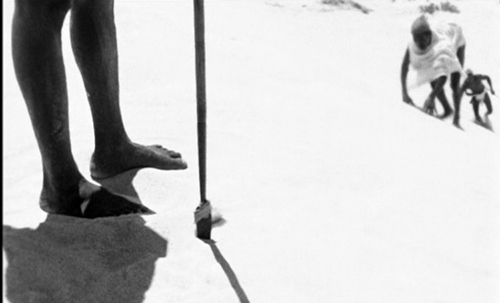
Kidoure’s capture: the warriors’ ancient attributes
© 1999 Blue Eye Films Ltd
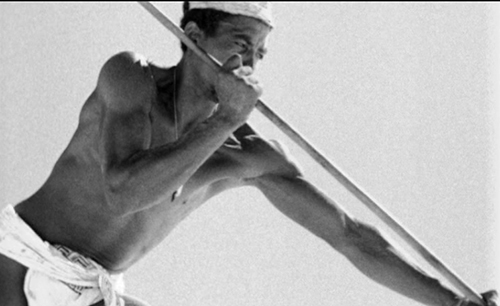
Makibefo striking the traitor or the ritualistic gesture of war
© 1999 Blue Eye Films Ltd
10Pictorial (semi)-fixity tends to impart an impression of the mythical which transcends immediate reality, the effect here created not unlike the ‘extra-realistic’, gothic or atmospheric effects created in earlier adaptations of the play.22 The film departs from the mere realistic to verge on the metaphorical. Such minimalism, an aesthetics of the sober (“épuré”) and the systematic privileging of visual aesthetics on the verbal, is a common adaptive choice in foreign adaptations.23 It ‘universalises’ the action as much as, or even more than, it ‘localises’ it.
Reverberating patterns: story and discourse
11The comments are also didactically effective in that they represent plot conflations or summaries delivered in an anticipatory way from the very first film shot: “Though the king was merciful he was also weak.” Telling occurs before actual showing. Later, the traitor will be shown mercilessly executed by Malikomy’s impulsive, avenging sword, despite the king’s pardon. In the same way, the sorcerer’s predictions are mentioned from the start: “The witch doctor looked deep into the eyes of Makibefo and saw that the gods had singled him out as a future leader. He inscribed solemnly the ancient symbol of the favoured one on his headband”: this is later fully visualised, and another visual echo is also provided by Valy Makibefo’s silent gesture on her husband’s forehead as he has returned from war. This duplicative system entails the creation of internal, meta-artistic echoes or even ironies, as here, for instance, the intra-diegetic (or semi intra-diegetic?) narrator is equated with the sorcerer-magician. The reiterative and anticipatory patterns at play throughout the film create reverberating and mirroring effects further allegorising the story and entailing an ‘essentialist’ approach. This to-and-fro also creates a distancing, second level of meaning, prone to erase the divide between story and discourse. As he points to the essential differences between the direct and commenting modes – the story as shown and the story as reported – Francis Vanoye explains that the commenting mode tends to create a distancing stance and bring stasis to the narrative.24 Christian Metz, as he comments on the ‘exhibitionist’ quality of cinema and the nature of the spectator’s voyeurism, contends that if the traditional, ‘fictional-narrative-representational’ film usually appears as a story, any film is, in fact, a form of discourse, despite its own attempts at masking its enunciation process:
In Émile Benveniste’s terms, the traditional film is presented as story, and not as discourse. And yet it is discourse, if we refer it back to the film-maker’s intentions, the influence he wields over the general public, etc.; but the basic characteristic of this kind of discourse, and the very principle of the effectiveness as discourse, is precisely that it obliterates all traces of the enunciation, and masquerades as story.25
12The alternation or quasi-coincidence of the two (verbal-visual) modes precisely tends to create a distancing effect sustained by the duplicative or reverberating patterns mentioned above, and enhances the dimension of discourse beyond the story. This does not entail narrative discontinuity or the usual ‘dysnarrative’ or deconstructive effects prevalent in conceptual cinema; the story, even represented in such a distancing, ‘metaphorising’ way, remains clear and fluid.
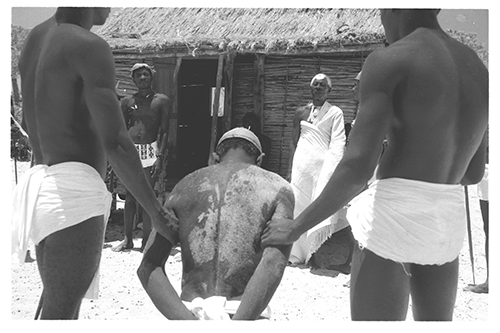
Traitor Kidoure (Boniface)’s capture
© 1999 Blue Eye Films Ltd
Madagascan magic, the witch doctor
13“Macbeth begins with witches,”26 Marjorie Garber recalls. Beyond the (slight) narrative displacement – the sorcerer himself is not seen from the outset but mentioned by the narrator (“He prophesied that a time would come, as surely as the tides, when peace and harmony would no longer sweeten the lives of the people”) – as the first encounter occurrs after the traitor’s capture, one may notice a cultural transposition or adjustment as the play’s three witches are turned into a single ‘witch doctor’ (Victor Raboelina27), a male sorcerer. This is in full keeping with local habits and traditions. Whitney Franklin tells us about the ‘traditional healers’ or ‘ombiasy’, still numerous nowadays, practicing medicine despite official prohibition imposed by the 1868 Code which includes 305 Articles (which have been recently challenged but that are still enforceable by law). Practitioners of this folk medicine deserve the two-fold name as both ‘doctors’ and ‘witches’, or ‘holistic practitioners’, as they can diagnose and heal diseases by resorting to magic or curses. According to traditional beliefs, a sorcerer is god-gifted and a “middle man”, or as Franklin puts it, “maybe not the one who is diagnosing a patient’s illness or recommending an herb for it,”28 but merely an intermediary power mediating between men and the divine. The witch doctor may then give advice in case a ‘fady’ (a ‘taboo’, something prohibited) has been committed; he is thus considered as perfectly qualified to tell one’s fortune or predict one’s ‘vintana’, fate or ‘Wyrd’,29 a term appropriate here in a context when ancient times and traditions are constantly evoked. Consulting witch-doctors is a usual practice. Such sorcerers usually resort to accessories like mirrors or series of rituals like lighting candles to practice their magic (light is deemed an essential element to establish a link with divinities). In the sequence, the sorcerer is here seen silently drawing small, geometric and cryptic figures on the sand with twigs or by means of small stones before delivering his predictions. The technique may evoke ‘sikidy’, the divine art of foretelling the future by means of disposing corn grains or fruit seeds in specific patterns.Sorcerers’ magic power is linked with the cult of the dead. Specialists Von Pischke and Octave Mannoni (a socio-ethnologist, psychologist and seasoned social observer, given his twenty-year-long residence in Madagascar and temporary governorship of the island30) both underline the importance of religious beliefs and cults in Malagasy tribes. Both writers explain that there are close ties, or that some form of ‘re-mediation’ exists between the living and the dead, or the immortal ancestor spirits (razana), the latter believed to have direct influence on the living’s daily life. The dead are thus held in high regard, honoured and revered with regular rituals (the famadihana31 or ‘turning of the bones’). The writers also explain that if many holistic healers or ‘Malagasy alchemists’ have useful supernatural powers (a vision of magic which coincides with the view of science in the Renaissance, half-way between modern science and occult magic), one should always be cautious and make a clear-cut distinction between white, or benevolent magic, and evil, or black magic practitioners who are ‘bilo’ (evil) possessed beings, deceivers and creators of havoc.
The witch doctor
Encounter with the male sorcerer (Victor Raboelina): close-ups and shots/counter-shots … Touch of evil
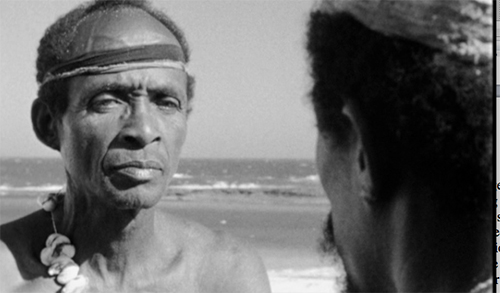
© 1999 Blue Eye Films Ltd
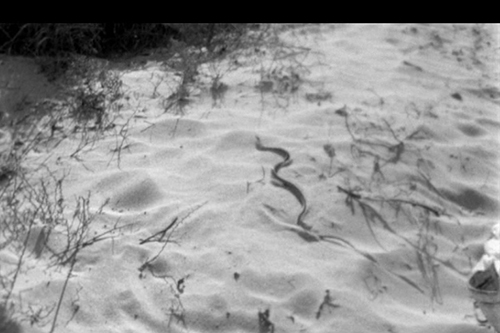
© 1999 Blue Eye Films Ltd
14Predictions are delivered by means of a few laconic sentences, clearly Shakespeare-based, but transposed with minor transformations according to the usual superimposition-simplifying-merging technique: “When the battle’s lost and won”; “What he will lose you will gain”; “Malcolm will murder your prisoner against Duncan’s will”. But the ominous meaning of the encounter and the presence of evil are suggested by such subtle hints as the sudden disappearance of the sorcerer abruptly jostled back by Makibefo (“Enough of your lies!”) and, then, a black snake is seen swiftly disappearing in the bushes. This works as an effective transposition of the image of the Weird Sisters melting into air, “Whither are they vanish’d?” (I.3.80).32 The storyteller’s first oral presentation, before the visual one, (“The witch doctor proved to be the teller of truths”) as well as the plot anticipation technique, (“Makibefo […] knew too, that once he had committed the ultimate treachery, there would be no turning back. The blood that they would wash from their hands would not so easily be washed from their souls”) also provide us with powerful proleptic hints as to the excruciating guilt that would torment both protagonists after the ‘deed’. The whole tragic concatenation of events is finally encapsulated in the brief, summing-up‘tale of damnation’ image. The encounter is highlighted as a turning point and the major event triggering the tragic process. Later, when back to fully intra-diegetic (visual) action, the storyteller sustains the action further by quoting Shakespeare-based comments in voice-over, “Can the devil speak true?” (I.3.107). The technique is effective as it creates a haunting, obsessive pattern externalising the emotions within and operating like their objective correlative, even if it is somehow redundant.
Sacrificial rituals, reiterative visual patterns
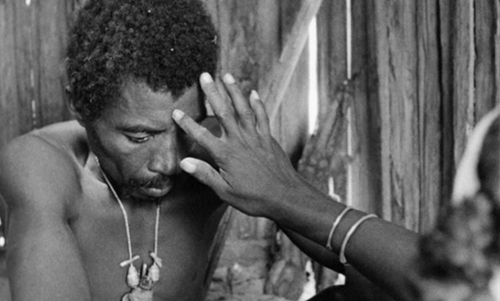
Valy Makibefo accomplishing the ritual of power
© 1999 Blue Eye Films Ltd
15The same reiterative patterns are used regarding traditions and cults, alluded to throughout the film. The self-referential title-cards at the end give explanations as to the film’s shooting and further enhance the transcultural experience: “We would like to thank the Antandroy people for their co-operation, their enthusiasm and their hospitality. Without them, Makibefo would never have lived”; “The zebu in the film was sacrificed in our honour according to the customs of the Antandroy people and was distributed to the families involved in the making of Makibefo.”
16The sacrificial dimension is here omnipresent, whether it be festive and sanctifying, with the zebu killing to celebrate a king, or sheer desecration, yielding to destruction. This is precisely an example of the transcultural process – merging or ‘deux cultures réunies’. The real (if not quite realistic), local rituals co-relate or ‘cor-respond’ with the play’s witches’ fictive, but no less sacrificial evil rituals, their occult knowledge, their cruel demands for innocent blood: “I’ll drain him dry as hay…” (I.3.18), their tragedy-propelling commitment not only to evil, but also chaos, hence the dishevelled ‘hurly-burly’ verbal image or the hysterical cauldron mantra, “Double, double, toil and trouble/ Fire burn, and cauldron bubble” (IV.1.10-11), here somehow displaced with the sight of women briskly grinding food with long, thin, spear-like, wooden pestles. Such images are not taken up in the sequences with the sober, dignified witch-doctor (Makibefo will meet him briefly a second time to learn more about his fate), precisely maybe owing to the sorcerer’s in-between social status. The long silences, the overall realistic mise en scène, the serene camera, set fixedly and closely in tight framings on both protagonists’ faces thus showing their clearly outlined features, the shots/counter shots suggestive of an ordinary conversation, all this does not really allow for gothic or atmospheric effects, but is more suggestive of an everyday context and situation.
17Yet even contextualising scenes like the coronation and zebu sacrifice ceremony are interspersed with metaphorical hints. On the one side, there are cultural adjustments, ritualistic, rhythmic dances performed with spears and accompanied by local-made music (with fipple flute sounds) recalling the ceremonial ‘fombas’ meant to establish the links with ancestors.33 They are here preceded by a kind of ‘dance of power’, warriors seen rhythmically tapping their feet and performing a mock dance by which they seem to be measuring their valour. On the other side, the obsessive, taunting rhythms conjure up the emotions and fears that the new king-tyrant experiences within, like the fear of treachery and loss of power. It is no coincidence that the zebu sacrifice is intermingled with – and implicitly parallels – the execution of Bakoua: the views of the clean, professional, slaughtering – the leg-strapping, the swift and efficient throat-thrusting and the animal blood mercilessly flowing into a basin34 – is intercut with several brief shots capturing Bakoua, trapped on the shore, relentlessly pierced by the two murderers’ swift spears and falling flat on his face onto the ground, the once ‘noble nature’ of a warrior so much feared by Makibefo biting the dust and reduced to a mere animal, panting and grunting before dying. The usual breathing, panting sound in the sound track in voice-over operates as the aural leitmotiv signalling death or the imminence of death. It is here the sign of an ultimate disorder, a disjointed, untimely sacrificial ritual to the forces of evil. During the sacrificial rituals, the ultimate moment itself is not directly represented, but suggested by means of an ellipse or a visual blank. The weapon lifting gesture followed by a short pause, a recurrent image in the narrative (Kidoure’s capture and then his slaughtering, the murder of Bakoua or of the Makidofys) becomes a visual leitmotiv. The warriors are seen lifting their spears high into the air and abruptly throwing them on their victims who remain unseen. The camera pauses on the tormentor’s arm lifting the weapon, and only the thrusting sound harshly penetrating bodies can be heard in voice-over, or sometimes a few soft cries in the background, as suggested by the savage slaughtering of the Makidofys performed by Makibefo himself. This is yet another hint at tradition, as Valy Makidofy (Simone Ratiandray Martine) and her three children kneel on the beach, recalling the treatment previously reserved to traitor Kidoure. The ellipsis or visual omission technique is used systematically to avoid showing the execution directly, thus erasing or at least distancing the moment, only to ritualise it further.35 Ellipses, visual and aural leitmotifs partake of the aesthetic parti-pris of sleekness and suggestive mode of representation meant not so much to deconstruct the verisimilitude effects, but to superimpose a metaphorical effect on them.
The zebu and the dead: tribes, cults and rites
18The cult of the zebu and cult of the dead are closely interconnected and of essential importance for all ethnic groups in Madagascar, Mannoni explains. The dead or immortal spirits are the source of everything and superior to the living: “The dead are the sole and inexhaustible source of all good things: life, happiness, peace, and above all, fertility36”. Their reverence is a social necessity. All the narrator’s scenes allude to such cults. The totemic sculptures seen surrounding the storyteller on the beach are also called ‘aloalo’, which means ‘intermediary’ or ‘messenger’. This suggests that they are the visible link or necessary connection between the living and the dead, a fact corroborated here as they reach high above human height, up to the sky, as if actually trying to reach it. Death is clearly seen as a passage or transition. The cult is prominent among the Antandroy who build their tombs and honour their dead in the same way as the southern ethnic group Mahafaly (‘those who make taboos’ or ‘fadys’) honour their chiefs and kings by decorating large tombs with heaps of sculptures and zebu horns – the higher the rank, the greater their number (a tomb may thus have upwards of 700 zebus horns). The Vezo, Rita Astitu observes, also revere the dead with numerous festivities (‘fombas’) or ritualistic ceremonies such as ‘the calling of the dead’37 when the living inform the dead of daily matters and seek advice – a common practice lest the dead might haunt the living and stir trouble.
19Such cults are less directly shown in the more ‘modern’ and globalising Souli. Local people are left in the background and the action is mostly conducted by the main protagonists. Yet one also finds here oblique traces of cultural spirituality with the reference to the mysterious Thiossan tale, continually mentioned but never actually explained. The tale is linked to the last heir and possessor, the Senegalese poet Souli/Othello. For the Vezo, Mannoni and Astuti explain38, the Hazoanga, the father or the elder in a family, is the natural interpreter of the dead’s will and he is supposed to act as the intermediary between the ancestors and his family members. Souli, influential and honoured both as the village chief and a spiritual figure of authority, could be regarded as such a father-like figure. If his role is prominent, he is also liable to arouse envy, which explains the latent rivalry and struggle between himself, Abola’s political king and king-merchant Yann/Iago. In this second film, there may be an essential dichotomy between spiritualism versus materialism.
Ritualistic sacrifices

Makibefo and Valy Makidofy (Simone Ratiandray Martine)
© 1999 Blue Eye Films Ltd
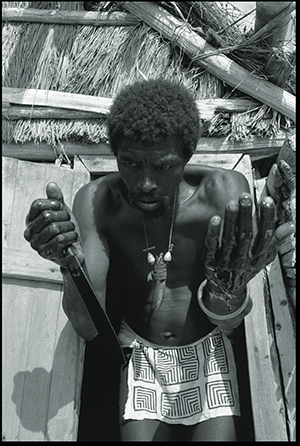
Makibefo’s dagger… and bewildered guilt
© 1999 Blue Eye Films Ltd
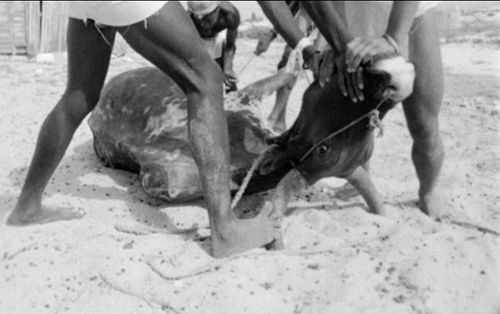
Festive rituals: the zebu ox sacrificed...
© 1999 Blue Eye Films Ltd
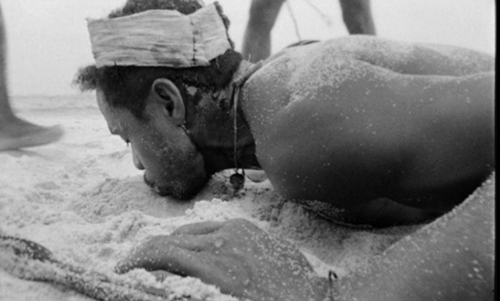
and evil sacrifices: Bakoua slain
© 1999 Blue Eye Films Ltd
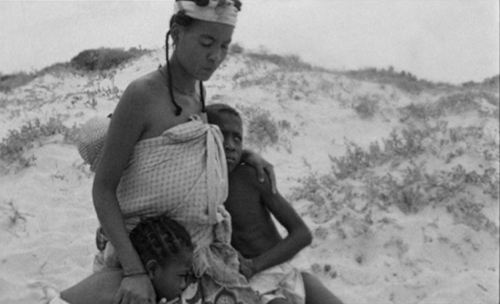
The slaughtering of the Macduffs
© 1999 Blue Eye Films Ltd
Haunting and the haunted: the spectral and the elemental
20Knowing about the prevalence of the cult of the dead among the Malagasy, it is not surprising that the ghost character should have a particular place in the narrative, with here again, a welcome correspondence between Shakespeare and Madagascar. Makibefo’s state of extreme fright as he is startled or caught by surprise by Bakoua’s spectral apparition, his unnaturally blanched cheeks suggesting the supernatural being, are all the more relevant as the image of the ‘awful sight’ externalising the protagonist’s guilt-ridden mind in a kind of hallucinatory phenomenon perfectly coinciding with socio-cultural beliefs and imperatives, in fact the extreme horror or even the virtual impossibility of such a spectral phenomenon. It would indeed be unimaginable for the Malagasy to let the dead rot on the beach or roam in the land without tombs or due burial. The visible ghost made real is the sign of ultimate damnation.

Haunting images: Bakoua’s ghost watching Makibefo, startled
© 1999 Blue Eye Films Ltd
21Earth, fire and water are the essential elements represented in an overall primitive, essentially elemental place, with water given a primordial place. The ocean stands as a full character in the film. The camera hauntingly returns to sights of the shore, offering views of a dormant, peaceful sea – “a reflected world as the conquest of calm”39 as Gaston Bachelard would put it, alternating with views of turmoil and the ocean splashing on rocks offshore. Valy Makibefo’s suicide is illustrated in a still, peaceful way, a “conquest of calm” indeed, again by means of restrained poetics. Lady Mkibefo, now fully insane, slowly enters the sea at dusk in a kind of Ophelia-like suicide. As she comments on the character of Ophelia, Ann Thompson refers to Gaston Bachelard40 who discusses ‘the Ophelia complex’ or ‘Ophelia syndrome’ and sees women systematically “associated with liquids: blood, milk, tears and amniotic fluid.”41 One may think of the “milk of human kindness”, an image conjured up by Lady Macbeth in the play: “Yet do I fear thy nature/ It is too full o’ th’ milk of human kindness” (I.5.13-14), duly taken up here and uttered in voice-over by the narrator and precisely suggestive of passive femininity. It translates Lady Macbeth’s fear that an ‘unsexed’ Macbeth might ultimately be too weak to perform the ‘deed’. As he ponders on the specific poetics of water and dreams, Bachelard also notices the links with femininity and the morbid attraction to water: “To disappear into deep water or to disappear toward a fair horizon, to become part of the depth of infinity, such is the destiny of man that finds its image in the destiny of water.”42 The alteration and intense suffering undergone by the guilt-ridden lady is fully visualised and followed in its gradual progress with extreme close-ups or tight framings on her face, catching blank gazes displaying no response to the surrounding world or suggested by the hysterical hand-washing scene. An interpolated scene also shows her, dagger in hand, a true, ‘unsexed’ Clytemnestra-like or Medea figure,43 recollecting the bold gesture she was about to commit herself as Makibefo, suffering from crushing despondency (too full of the “milk of human kindness”), was victim of a temporary defection and left powerless on the beach. The suicide itself is not shown but treated off-camera by means of an ellipsis. Makibefo, later at night, is seen walking on the deserted beach only to discover a crushing absence, the forgotten ‘lamba’on the sand and his wife’s footsteps leading to the shore. In the usual visual-aural dissolve, the image softly fades into a remote, poetic long shot while the narrator is heard in voice-over uttering the full “tale of an idiot” speech: “Tomorrow, and tomorrow and tomorrow, […] Life’s but a walking shadow, […] It is a tale/ Told by an idiot, full of sound and fury,/ Signifying nothing…” (V.5.19-28), the visual and aural once again echoing in fluid correspondences.
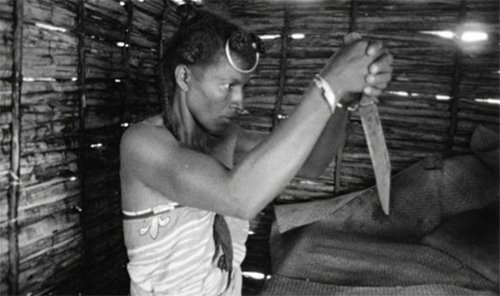
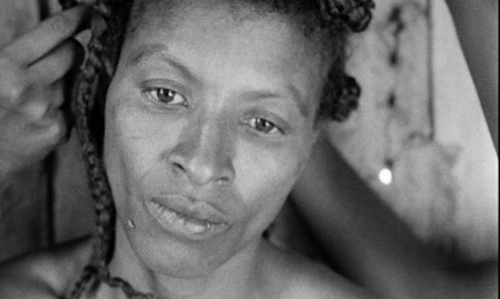
Guilt-ridden Valy Makibefo recollecting the attempt at performing the ‘deed’ …
© 1999 Blue Eye Films Ltd
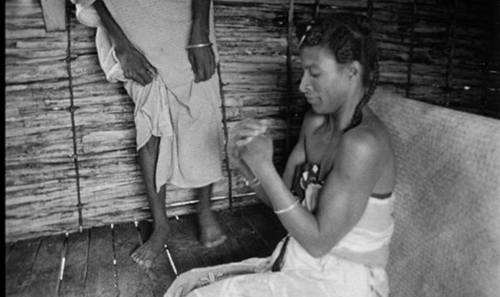
… and ensuing madness
© 1999 Blue Eye Films Ltd
The open seas: redemption and retribution
22Retribution and justice eventually come from the open seas, as a few pirogues, all sails out, are seen slowly approaching the shore, bearing in their frail shells Makidofy (Jean-Noël) the avenger, Danikany’s two sons and a dozen warriors. This indeed had to be the local, convincing transposition of the Birnam forest image for the arid Tolaria-located Faux Cap, but with the multitudinous mirroring reflections on the sunset-lit sea and the view of the warriors facing the tyrant, their silhouettes outlined on dusk-lit skies and barring the sea shore, the scene is also conferred a dream-like effect verging on the metaphorical. The long moment of stasis and silence before the final confrontation also conveys a sense of unavoidability and turns the story into a visual tale: from the ocean comes the end of illusory power and the all too real retribution.
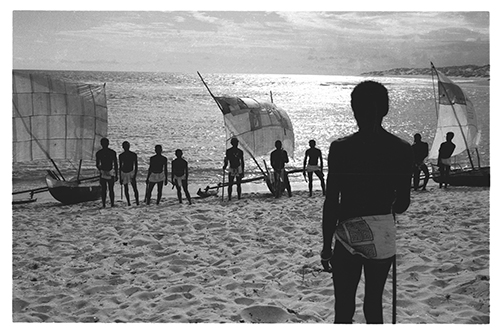
Malikomy’s return: redemptive ocean and final encounter
© 1999 Blue Eye Films Ltd
23Makibefo, galvanised by the witch doctor’s prophecy – “No man born of a woman must you yield” – unwittingly refuses – “There is none of you I fear” – yet attempts to avoid fighting Makidofy: “You of all men I have avoided. My soul is too much charged with blood of yours already. And you are not of woman born.” This before the ultimate truth and revelation of the string of evil equivocations dawns on him:“Macduff was from his mother’s womb/ Untimely ripp’d” (V.5.44-45). As Malikomy finally strikes the tyrant, the moment of the execution is operated according to the usual death ellipsis suggestive technique, but the finally vanquished tyrant is then shown lying on the ground. This may be one of the few, fully shown, images of a dead man.44
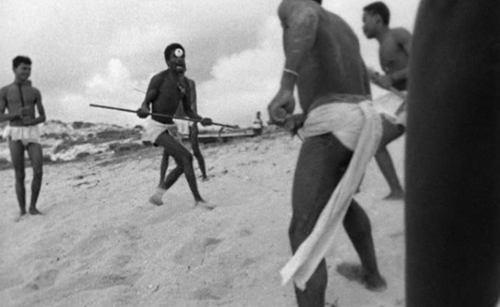
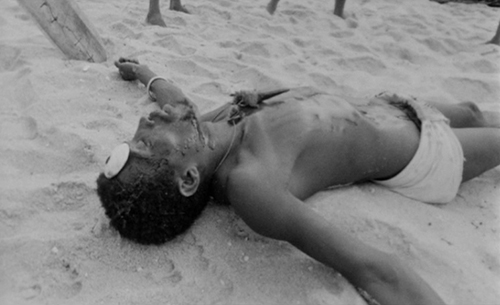
The final ‘dance of death’ and the tyrant’s execution: the last of rituals
© 1999 Blue Eye Films Ltd
Circular patterns of power: from immemorial times to the present times
24If the choice of fishermen descending from the Antandroy responded to the desire to work with an uncorrupted, independent people in step with its traditions, the film basically a metaphorical tale hinging on human, universal flaws, the local dimension is also fully present.45The film shows recurrent views suggestive of the corruptive force of power, somehow recalling Wilson Knight’s “Wheel of Time” image for a play on “the metaphysic of evil”46, or Jan Kott’s famous quote expressing the pessimistic vision of History trapped in tragic time patterns: “[T]he history of the Renaissance is just a grand staircase, from the top of which ever new kings fall into the abyss.”47 Such a vision may be conveyed here as the successive royal couples displaying all the attributes of power (white cloths on the kings’ foreheads and white sheets) are presented in an exactly similar way and the two couples filmed in perfect filmic stasis. This goes beyond mere contextualising or recurrent ‘localising’ and ‘traditionalising’ effects. The duplicative effect enhances a circular pattern suggestive of the inevitability of power and its tragic excesses illustrated in a dual way, both local and universal.
The circularity of power in Makibefo
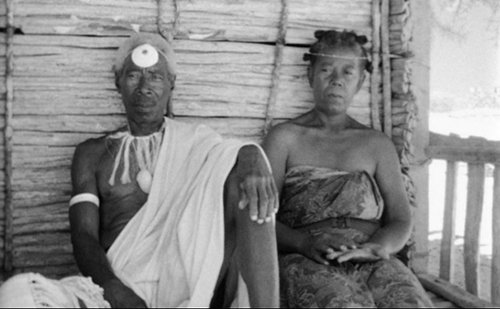
Filmic stasis: Danikany and Queen (Todia)
©1999 Blue Eye Films Ltd
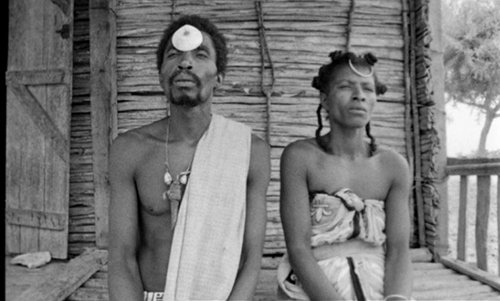
Makibefo (Martin Zia) and Queen (Noeliny)
©1999 Blue Eye Films Ltd
25In Othello-based Souli, such patterns of power abuse are represented in the same dual way, although monstrosity here takes on a prismatic form, as it depicts various forms of rivalry and jealousy in the subtle game of chess played by the protagonists.The experimental stand is still present, adapting Shakespeare with Malagasy locals, but more scope is allowed to the play, the film relying more directly on the source text, as if the director implicitly acknowledged the basic differences regarding the different natures of the plays. Macbeth is a dark tragedy allegorising evil anduniversal themes, or, as Kenneth Muir puts it, “the greatest of morality plays,”48 whereas the second, a “tragedy of love” (“Eros in tragedy”49) raises personal issues, deep emotions and passions (“tidal, deep and uncontrollable as the ocean”50), which entails full and complex characterisation. This is allowed in the film with the choice of longer dialogues directly drawn from the play, however simplified and conflated and delivered in French by professional actors, even if white protagonists occasionally use the local dialect (as in Yann’s very first words to Saikou or, later, Mona’s conversation with the villagers in her workshop). A full crew of technicians, including Jeppe Jungersen,51 also allows for a more elaborated staging to adjust to the demands of a domestic tragedy. The choice of western-located Ambola amongst the semi-nomadic Vezo tribe, precisely the “people who fish” or are “struggling with the sea”, also grounds the film in the present, even more so than Makibefo. As it highlights the particular importance of the fishing economy for contemporary Madagascar society, this points to broader socio-economic and ideological issues related to the future fate of a forlorn island struggling to assert itself in a global, materialistic world. Yet this is also a cultural and aesthetic venture. The director explains that there were actually two versions of the film: one in 2004, completed by a second one in 2006 showing a new opening sequence, in particular the character of Ali Wagué52, the strange flute player or the man speaking withnotes, “l’homme qui parle avec des notes”, seen riding his bike in busy Dunkirk harbour.53
Kings and queens in Souli, games of chess and criss-crossing patterns
26This is no immemorial tale of damnation, but the illustration of a harsh struggle for influence and power. Contextualisation is again effective, with recurrent views of Ambola’s fishing or everyday-life activities. But a pattern of basic oppositions Òbetween the local, rudimentary means and the more technologically advanced ones underlines, from the outset, sharp contrasts between the haves and the have nots. Hence Saikou (Lejeune) is seen repairing his wooden ox-cart in the opening sequence, silently observed by Carlos, the white stranger (and intruder), himself waiting for some means of transportation. The quietness is abruptly disturbed by the arrival of Yann’s aggressive truck, noisily making its way on the sandy, windy tracks. The traditional pirogues or dugout canoes are seen sliding swiftly on the ocean waves, but they hardly compete with the speed and effectiveness of Yann’s motor-propelled pirogue. This pattern allows for a visual, sober illustration of the distribution of power prevailing in Ambola.
Daily life scenes: contextualisation
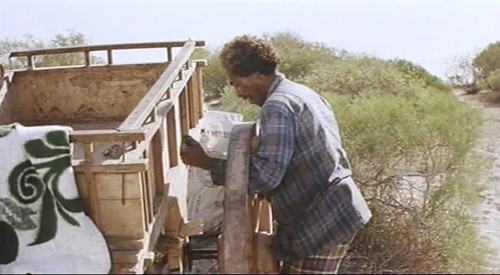
Opening sequence: Saikou’s ox-cart
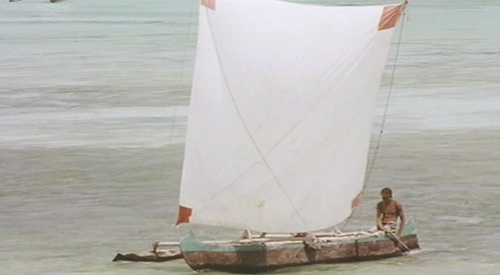
Dugout canoes, traditional pirogues or motor-propelled one?
Courtesy of Alexander Abela – Gondwana Dreams & Red Island Productions © Alexander Abela
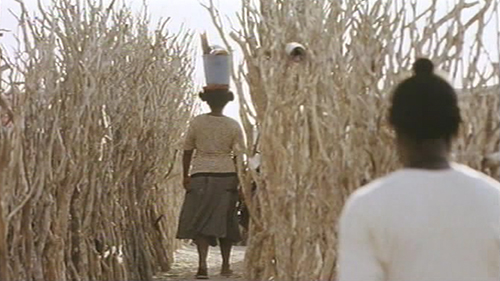
Village view (Souli, seen from the back, in the right-hand corner)
Gondwana Dreams & Red Island Productions © Alexander Abela
27The heart of the matter is economic power, influence or political supremacy, distributed according to two main axes. Basically, two couples share power and influence: Yann and Abi, his black companion, and Souli and Mona, the poet and the idealist, each couple exemplifying a vision of the world. The whole economy of Ambola rests upon the trade activities of Yann, the Iago figure (Aurélien Recoing), the undisputed merchant-king of the lobster local industry, who has managed to create a monopoly for himself as he is the only one disposing of ice able to keep fishing products fresh. He also has the monopoly of oil and transport and can thus exploit the local fishermen with total impunity. The self-proclaimed white king of the place assumes a rank higher than the play’s envious and spiteful Ensign somehow relegated to the secondary role, always concealed or plotting in the background. Yann patronizes and bullies everyone, even his own black companion Abi/Emilia (Fatou N’ Diaye). Abi is not a local, but comes from Mali, she is clearly a displaced foreigner, as shown by the slightly scornful nickname given to her by the villagers: ‘La Malienne’. She appears as the typically divided African in search of her true identity, torn between contradictions, both westernized and inhabited by urban dreams, craving to leave this backward spot for good to reach an idealised civilisation (“I’m going to study business in Paris”), but also enjoying singing Madagascan songs and tunes. She is generally mocked by the Ambola villagers for her pretences at social differences – “she thinks she is a city girl”. This operates like a two-fold example of ‘displacement within’, somehow echoing the aristocratic society of Venice. Abi shares with the play’s assertive Emilia distrust and anger against unscrupulous men, ‘belching’ women after using them, as shown by her occasional fits of rebellion against her companion’s humiliating attitude such as, at the beginning of the film, when she is asked to give the front seat to the stranger and to climb in the back of the truck54 (“ça va pas, non?”55); or, further on, when she rebels as Yann practically twists her arm to take from her the bracelet she has spitefully stolen from Mona (she feels a jealous rivalry to her). But she will be left utterly terrorized and powerless after being harshly beaten by Yann and turned into a mere instrument for his evil plot,56 as the now hateful trader aims at framing the drunken Carlos for the deed and expelled. Souli/Othello (Makéna Diop), ‘the Senegalese’, is the male counterpart, also a black, displaced African. Here, however, it is the other way around: he was once a reputed writer and poet who chose to flee civilisation for a peaceful, contemplative retreat. He represents an effective transposition of the “sooty-bosom” Moor and “Barbarian” of the play, both as a stranger and undisputed figure of authority as village chief. Mona/ Desdemona (Jeanne Antébi), her companion (and also Yann’s former companion), runs a local craft workshop selling hand-made painted giraffe toys to tourists.
28The filmic narrative rests upon a chiasmic crisscrossing of genders and races, Yann-Abi versus Mona-Souli, the European dominant class versus the poor, local inhabitants struggling for survival and economic independence. This defines a prismatic, checkered landscape where conflicting interests and rivalries soon turn into a relentless struggle for economic, moral and sexual supremacy. This prismatic pattern of intertwined jealousies or covert rivalries (political, economic, sexual) draws the political map of Ambola, the sole location (there is no divide between Venice and Cyprus as in the play) whence all violence stems and which becomes the main stage of violence or a symbolical tragic microcosm. The ultimate pursuit of power eventually leads to a deadly game of chess, which aptly reconstructs the original model which Ania Loomba sees as “both a fantasy of interracial love and tolerance, and a nightmare of racial hatred and male violence.”57
29The life of Ambola is indeed entirely ruled and ordered, as if rhythmically pulsated, by the comings and goings of the two couples and dominant quartet, Yann/Abi and Souli/Mona, a square and balanced structure, seemingly living peacefully together until this fragile equilibrium is questioned by the impromptu arrivalof Carlos (Eduardo Noriega)/Cassio, the Spanish doctoral student who has come all the way from Europe in a Quixotic search58 for the mysterious Thiossan tale which, he says, is “believed to be lost”, “not written, and from the oral tradition”, but which he “has good reason to believe” has been secretly and ultimately inherited by ‘the Senegalese’. The ‘étrange étranger’, strange foreigner, both outsider and naïve intruder, turns up when least needed, only succeeding in disrupting the self-centred ballet embodied by the dominant quartet. He represents a potential danger which is immediately sensed by Yann, who welcomes him with a warning: “There’s no whites here, so don’t mess things up.” Carlos’ attempts to convince the now retired Souli to publish his works will meet but scornful rebuke as the poet suspects vanity (“He simply wants to sign the preface of a best-seller”) and Mona’s generous attempts to make her companion reconsider his stand (a displacement for Desdemona’s role as a benevolent intermediary after the brawl caused by drunken Cassio59) will merely arouse Souli’s jealous suspicions and precipitate the tragedy.
30Mona, like Desdemona, is an illustration of the ‘kalon’or ideal of beauty, the pole of moral integrity struggling against the ‘kakon’ or the ugly;60 but here, far from any pure, submissive ‘white dove’, she appears actively involved and a strongly assertive character, daring to challenge Yann, if not competing with him, such as when she violently chides him for eating lobsters when the villagers, who fish them, but do not even “know the taste of it” (a typical example of a post-colonial situation), or even worse, when she dares to challenge his monopoly. When Mona becomes involved in co-operative activities and the creation of an ammonia-built ice-making machine, a rudimentary ancestor to the modern fridge, her attempt at making the villagers reach full self-reliance abruptly disrupts this fragile balance resting on a pattern of domination. As Yann has come to snoop into the workshop, she welcomes him with a provocative, “Take a good look at it, Yann. What you can see here, is the end of your monopoly”, a daring, but not very cautious attitude, as Yann now understands her plans and will start coining his Machiavellian plots.
31Political and economic powers are not distributed in an equal way. If the village chief and the king merchant seem to be cohabitating peacefully, a discrepancy is subtly hinted at, as Yann, buying Souli’s fish, is seen exploiting him no less than the other villagers (“Without you, Souli, I could not make a living with their lousy catch”); and covert, political or sexual rivalries can be sensed between them. Yann later vainly tries to convince Souli to refrain Mona (“Tell her to back off”) with an ominous warning, “I will not give up my place so easily. Not a second time”, or in one statement clearly echoing Brabantio’s warning to the Moor: “Beware of her. She’s deceived more than one”. Souli’s unresponsive, sceptic answer – “What are you afraid of? Losing your monopoly? Everything has an end” – is a direct and frank response revealing Souli’s naivety, unaware of Yann’s potential for evil. Such naivety also echoes the Moor’s stubborn convictions about ‘honest Iago’ in the play.
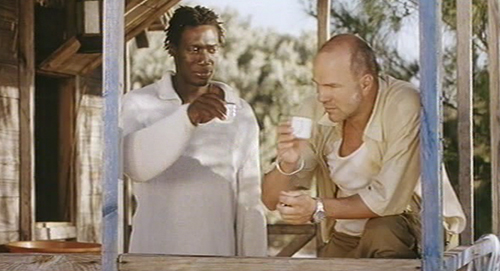
The poet (Souli/Makéna Diop) and the merchant (Yann/ Aurélien Recoing): temporary agreements or illusory peace?
Gondwana Dreams & Red Island Productions © Alexander Abela
32When Yann later confronts Mona in the workshop trying to hide the mysterious ice-making machine, his violent rage towards her is still clearly mixed with strong sexual attraction. Incidentally, the original jealous sexual envy, not entirely negative at this stage, is more suggestive of Othello’s own towards Desdemona, which draws an implicit parallel between Yann and Souli, and makes them appear as doubles. The scene, Calbi suggests, also evokes sheer lust or the less noble fantasy of possession or rather repossession of “the love object lost.”61 This is a climactic moment occurring half-way through the film, one of the same dramatic intensity as the ‘ocular proof’ scene (III.3), and probably its adaptive equivalent here. A clear degradation had been previously suggested, as Yann was seen suspiciously spying through the twigs-made (jalousie-like) hut wall, and further corroborated as he finally discovers the refrigerated fish in the wooden box. This time, dramatic intensity no longer hinges on love jealousy, but shifts to sheer rivalry. As Mona now seems definitely lost as a woman and mate, defiance and hatred will, from then on, prevail and evil take the lead.
The core of the matter: sexual and economic jealousies, intertwining patterns
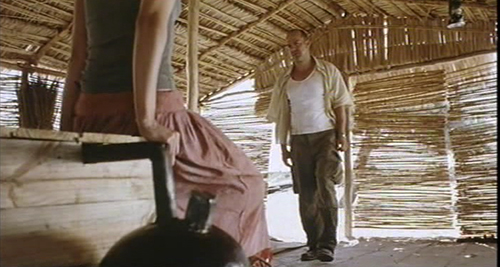
Mona hiding the ice machine
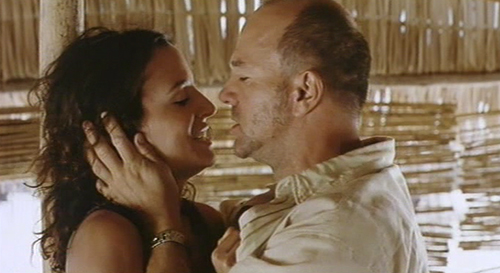
Personal encounters
Gondwana Dreams & Red Island Productions © Alexander Abela
33Ultimately, local ice is made, the ice cube triumphantly droppedby Mona into Yann’s glass, another imprudent provocation, and the first papaya ice-creams joyfully welcomed by the villageÒ children. The tragic process has been triggered off. Further down, infuriated Souli, sick with jealousy, will be seen breaking the ice-making machine into a thousand pieces.
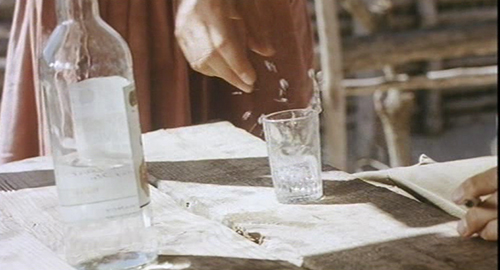

The ice: Mona (Jeanne Antébi) ’s provocative triumph before Yann, Abi (Fatou N’ Diaye), Carlos (Eduardo Noriega and Souli)
Gondwana Dreams & Red Island Productions © Alexander Abela
34The second half of the film unfolds according to a quicker rhythm built up on the same pattern and concatenation of events as in the play, with the bracelet-handkerchief gulling scene, Souli’s excruciating pangs of jealousy, Mona’s murder and the final transmission of the tale to Abi by a dying Souli. Despite the gender-race balance of the quartet, a full auctorial creation, one finds many echoes of the play, but also conflations, as the play is transformed or “transmogrified”62 in a simplifying mode with Carlos’s naivety for both Roderigo and Cassio’s gulls, Abi conflating Emilia and Bianca, Yann playing both the covert, envious Ensign and the openly self-proclaimed King of the place, Mona as pure but assertive, here even turned into a “fair warrior”, or Souli the foreigner and figure of authority, who is no longer a brave warrior or man of action but a contemplative writer poet.
35As Emilia is bullied, then manipulated by her evil husband in the handkerchief scene, the now fully terrorified Abi, who has lost self-control after being thrashed by Yann, will be unscrupulously used as a decoy to entrap Souli. At this stage, like the self-trapped Iago in the play who has no other choice than to find an ‘ocular proof’ to disentangle himself from his own lies, Yann has to convince Souli of Mona’s adultery to finally defeat her and regain control, so that, as an ultimate trap, the merchant eventually forces Abi to make Carlos wear the bracelet stolen by Abi to gull Souli. Abi is obeying out of mere fear of retaliation and, like loyal Emilia, will then reveal the whole plot to Souli, only a few minutes too late, after Souli, silently weeping, has killed Mona, suffocating her with a cushion. Carlos, taken away from the village on Yann’s boat but sensing the disaster to come, has hurriedly swum back to shore, only too late.
36The bracelet-handkerchief scene is an effective adaptive displacement (the bracelet once belonged to Souli’s mother and was given as a most precious token of love to Mona). Such plot simplification is made possible with the choice of Madagascar, at the far end of the world, where the social organisation rests upon primitive codes of conduct and virtually no (or little) prevailing law and order, as shown by the detail of Yann, on the departing boat, advising Carlos simply to appropriate or ‘take’ the tale for himself, as everyone here is above the law – “Tu n’as qu’à le prendre. Ici on est au-dessus des lois.” Yann’s pragmatic philistinism also shows in the terms he uses, such as when he equates the tale with a mere commodity to be ‘handed over’ (“Il t’a cédé le conte?”). In such absence or feebleness of social and legal structures, the place out of reach of any of the alleviating powers of law and order is bound to ‘make one mad’ and become Cyprus-like, a place epitomising primitive chaos.
37Souli now comes to his final encounter with Yann who, back on shore, stands motionless, waiting, knife in hand. Souli strides steadily towards Yann and symbolically commits suicide by throwing himself deliberately into his arms and onto his knife, then left dying on the beach, a final ritual and “dance of passage.”63 This scene showing the two brothers and equals in love united in an ultimate, deadly embrace may also be suggestive of what Jack Jorgens calls “the perverse marriage of Othello and Iago”64, in particular in Welles’s version, or an ironical distortion of the Eros-Thanatos classical ‘tragedy of love’ themes romanticising the protagonists’ deaths (Othello and Desdemona finally reunited), as in Yutkevich’s film when Othello is discovered “obeisant at Desdemona’s feet,”65 then carrying the dead body up to the tower before stabbing himself.
38As Yann is eventually seen fleeing in his pirogue, away from the shores of Ambola and out onto the open sea and other foreign spaces, seemingly ready to export evil elsewhere, the ending appears as all too open and pessimistic, with no retribution, allegorising the idea of evil irremediably escaping man’s justice. The Ambola tale can then take on the tonality of a parable or a mystic fable, the village yet again turned into a metaphorical microcosm epitomising the story of a global world forever condemned to remain under the evil spell of corruption, were it not for the final passing off of the Thiossan tale legacy from the dying poet to Abi, the African sister unexpectedly becoming the new disciple and bearer of ancient traditions. This is done despite her obvious hesitation and but a timid, silent acknowledgment, and also, Calbi suggests, despite the overall ‘uncanny’ aspect of the process, as the Westernized girl and the poet stubbornly try to maintain the ancestral traditions, while being “such unlikely partners.”66 Incidentally, this also works as a form of restoration, re-positioning the bittersweet, negative-positive ending of the tragedy of love.
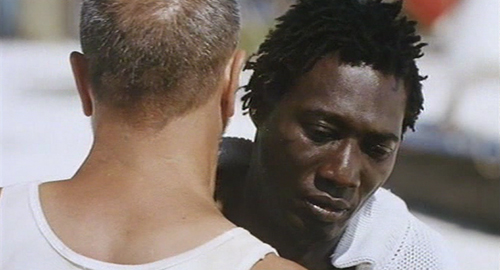
Yann-Souli, the final embrace of death, the ‘tragedy of love’ ironic distortion
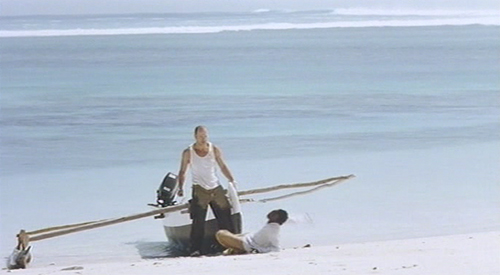

Evil escaping retribution
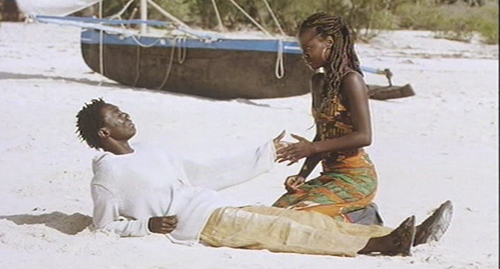
Transmitting the tale
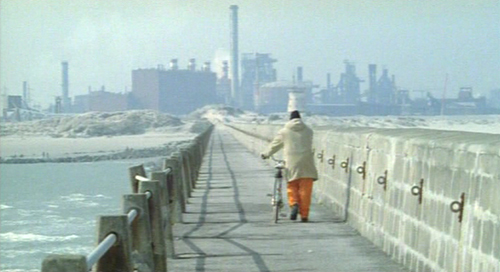
Ali Wagué – 2006 version – Closure sequence
Gondwana Dreams & Red Island Productions © Alexander Abela
39Yet the final optimistic hue is itself contradicted, or at least questioned, by the closure sequence, which again takes place in Dunkirk, creating a circular pattern setting the action in a wider, urban and global context.
Framing devices
40The 2006 opening and ending sequences represent framing devices, akin to film-within-the-film devices, encompassing the Ambola-Shakespeare narrative and placing it within a more global perspective. The narrative does not open on Yann’s dusty truck following the sinuous, deserted paths in its relentless quest for local fortune, but on the views of Dunkirk harbour where the character of the flute player (Ali Wagué) is seen riding his bike on the deserted road along the jetty with, in the background, a feverish industrial and commercial activity. He is then seen silently playing the flute, Souli’s voice heard in voice-over addressing the audience, “Listen to this man. His notes are words”; “Hear an exiled author’s message”, then to the flute player, “You my friend, who speaks with other voices, your ancestors have enabled me to perform the initiatory dance, so that destiny may finally be accomplished,”67, “Shout louder than the winds” and Souli finally addresses the ‘Spirits of the deep’, urging them to “join with me in telling this mysterious story”, asking for “Peace, like a cooling wave for a burning land.” The allusion here is to the protagonist’s future death and uncertain state or inability to reach the ancestors’ land (hence the project to add a new opening sequence).
41The choice of the harbour as a place of transit, one “denoting the excesses of industrial production”68 as Burnett notices, establishes the link with the global world and economy. The flute player “attired in his ubiquitous orange manual worker outfit, […] similarly brings to mind the typical émigré and his menial employment,”69” which, as it points to the base employment situation of local inhabitants also points to the usual post-colonial schemes and patterns of ‘domination and subjugation’ or else the “construction of imprisonment”70 inherent to post-colonial societies, here mainly the French ones, Madagascar, Guinea (Wagué’s country), Senegal (Souli), or former French colonies elsewhere, if one thinks of Laumord (from Guadeloupe) in Makibefo. The image evokes such post-colonial connections. The curious flute player character seen riding his bike alone in busy Dunkirk may also illustrate the uneasy route which leads to genuine economic independence, in the same way as Mona’s victory is but slow and gradual: if the discovery of the ice-making machine is a definite victory, it is one hardly won and ultimately deadly.
42Youssef Ishaghpour saw Othello71 as a tragedy built on circular, reiterative patterns. The ending which shows the flute player again, intercut with the silent death and passing of the tale to Abi, then the player walking towards the harbour industries set the action in a circular pattern, and confirms the enlargement of the action to a global perspective. The flute player from Guinea, and Souli, the Senegalese poet, two African strangers from within, almost ‘Barbarians,’ are somehow equally displaced in either urban or rural locales, and yet at the same time paralleled in their specific status as tale bearers or storytellers, as if the new African kings of dreams or artistic chimeras were displaced in a prosaic, ruthless and materialistic world (whether it be Dunkirk or Ambola) and seen from the start as the emissaries of another, deeper world based on traditional values and genuine culture. Calbi here notices an interesting inversion, the visual image of the player in the opening sequence soon giving pride of place to Souli’s voice in voice-over and then the shift between the visual image in the opening sequence to voice at the end:“at the beginning Souli speaks without a body, and at the end, this is a body without a voice.”72. Such a shift and chiasmic effect (flute player/Souli, visual image and voice-over operating in parallel) precisely helps make this equation between the two poetic – and heroic – storytellers and tales-bearers, underlining their role as the guardians of artistic vanities in the global world.
43Souli remains an unfinished work as the film has been through several financial and legal difficulties (the DVD is not for sale yet). The director explains73 that he considered substituting a new opening sequence for the present one and show Souli walking alone in an alley hedged by two lines of high cacti, trapped in a kind of in-between area and unable to reach the ancestors’ soothing land before being forgiven for his crime (another reference to the cult of the dead). It would then be the task of Abi, the African sister, to write Souli’s story ending and turn it into a true tale by making him finally able to find eternal rest. As it stands, the film has not been transformed yet, itself trapped in an in-between financial and legal, uncertain state.
African kings of modern times: Makibefo, Souli, post-colonial patterns
44Octave Mannoni, then a twenty-year old resident and local governor of Madagascar, explored at length the complex links presiding over the relations between French settlers and Malagasy natives. As Alden and Virginia Vaughan remark, if their book entitled Psychologie de la colonisation, Mannoni first provides us with a “complex analysis of colonial interaction in Madagascar alone,”74 as his book came later to be translated with the title Prospero andÒ Caliban: the Psychology of Colonization, thus establishing a striking parallel with the master/slave relations depicted in The Tempest. Mannoni also raises wider issues about colonial and post-colonial interactions. Drawing from his Malagasy experience, the author develops the idea that there exists some form of psychological interdependence from the settlers to the colonised, the former suffering from a kind of ‘Inferiority complex’ which he calls the “Prospero complex”, whereas the latter, suffering from what he calls the “Caliban or Dependence complex”, would be in perpetual search for a master:
A colonial situation is created so to speak, the very instant a white man, even if he is alone, appears in the midst of a tribe, even if it is independent, so long as he is thought to be rich or powerful or merely immune to the local forces of magic, and as long as he derives from his position, even though only in his most secret self, a feeling of his own superiority.75
45Such complex relations based on dialectical patterns of actions and responses have led to a colonial situation defined by the “domination of a mass by a minority, economic exploitation, paternalism, and racialism,”76.To define the “Prospero-inferiority complex”, Mannoni describes the Europeans colonisers as exhibiting “the need to feel highly regarded by others”, prone to display a “grave lack of sociability combined with a pathological urge to dominate”, which could “urge them to seek a situation with servile people.”77 Thus, the settler’s potentialities to conquer the place and master the native population do not rest so much on strength and a brutal displaying of power, but on his political ability to convince the colonised that he, and no other, is indispensable to the native’s well-being. Such an attitude might well fit Janus-like Yann, whose behaviour oscillates between sheer brutality and a patronising stance, with women and the local villagers, one also grounded on the need to feel indispensable. Yann’s monopoly does make him indispensable to the villagers’ survival, which allows him to behave in an authoritarian and domineering way, as when he is seen yelling at the unproductive fishermen: “No lobsters? What’s going on? You take me for an idiot?” This stands as a clear example of the typical patronising attitude in post-colonial societies, and also, as Calbi remarks, “one of racially inflected brutality,”78 all the more so as he is prone to mistreat his own black companion, Abi. Conversely, the colonised Malagasy may suffer from the “Caliban-Dependence complex”, feeling “neither inferior, nor superior yet totally dependent”, needing to rely on the colonisers and in a way ‘attached’ to dependence or at least reliance on the colonisers, because, Mannoni argues, after being driven away from their tribal traditions and stable routine by colonisation, they feel the need “to avoid a sense of abandonment.”79 Yet this ‘dependence’ complex does not entail any acceptance of inferiority of any sort. If, in a way, this could be reflected in the villagers’ overall placid, mild acceptation of Yann’s behaviour and their own condition, as well as in the need of Mona’s strength to spur them on, this is at the same time clearly deconstructed by such a view of native Buba (Ravelo), jubilantly tricking Carlos into buying bad beer, then mocking the gull and “silly foreigner” unable to “make his own hut”80, and eventually even shown putting up Carlos’s tent for him. This could be read as an ironical reversal and deconstruction of the simplistic patronising-dependent image. The issue of dependence-minded natives is also questioned as the villagers are seen effectively making ice and reaching self-reliance, even with Mona’s help. In the same way, if Abi, at the beginning, could be seen as the perfect example of ‘assimilation’ – a native no longer able to ‘connect’ with her own culture –, the ultimate reversal, as she finally accepts the Thiossan tale transmission by Souli (a cultural covenant), eventually comes to terms with her specifically African identity, enhancing the importance of such cultural and political issues. Souli could be seen as an example of the doubting, divided self described by Richard Marienstras as “l’époux éloigné”, struggling against covert, nihilistic evil exemplified by Iago (“l’individualisme nihiliste”81), as well as an example of ‘half-way’ assimilation, seemingly accepting the presence of Yann and his materialistic superiority, but also fully able to appreciate the local ice-making machine and discard Yann’s pretences at keeping his monopoly forever.
46Mannoni’s theories have their limits and were indeed criticized by such writers and philosophers as Aimé Césaire and Frantz Fanon for their ‘hollow’ notions, as Chantal Zabus has shown,82 the ‘dependence complex’ in particular was considered outdated. But the master/slave (Prospero/Caliban) metaphor remains relevant for both Madagascar adaptations, Souli especially, clearly expounding on the mechanisms of economic exploitation and interdependence, and also implicitly Makibefo, when the director insists so much on making a film with the proud, independent Antandroy people, one, precisely, “not submitted to the French.”
Conclusion: local politics and post-colonial connections
47Modern political issues are also key, linked with these post-colonial issues. In the presentation of Makibefo in La Clef cinema, many questions arose from French people (of Malagasy origin or from people who had lived there) as to the actual importance of the political dimension in the play. Several members of the audience were actually struck by the possible analogy between the ‘tale of damnation’ and the political situation in Madagascar which was seen evolving towards increasing restlessness and discontent. Before the independence from the French in 1960 and even to this day, the history of Madagascar has been a long struggle for the control of power, displaying a string of troubles, protests and violence with one political assassination, two military coups, one from Didier Ratsiraka, who then ruled as the President from 1975 until 2001 (but who was ‘ousted’ in the early 1990s); the presidential election opposing him to Marc Ravalomanana was harshly disputed (blockades were even raised in the capital) and the outcome constitutionally challenged,83 which forced Ratsiraka to fly hastily to France in July 2002. Of course, added to all that were economic disruptions of all sorts. No doubt that Makibefo should have rung more than one bell for the Malagasy present in the audience in the 2002 Paris presentation, precisely as those events unfolded.
48Such issues are also prevalent in Souli, which draws more directly on current socio-economic issues. Basic symbolical oppositions may be made out between two poles, one materialistic Yann’s unscrupulous philistinism, and the otherspiritual, exemplified by the Senegalese poet-writer Souli, the other ‘étrange étranger’ displaced in several respects, both as a foreigner and as a stranger to the requirements of modern, global times. This last could also apply to the storytellers or bearers of tales. Both Makibefo’s storyteller and Souli’s flute player stand as the vectors of traditional truths to be told and forever perpetuated. All are linked, the poet, the anonymous flute player, the narrator or even the evanescent Thiossan tale itself (and Abi, ultimately), all men or things essentially alike in their African quality and as they represent the commitment to spiritual values, poetry, art or the realm of the dream-like. Thus, the final, optimistic transmission of the tale could suggest the possibility to escape the circular and obsessive tragic patterns of time, were it not for the vague subsistence of an ambivalence as the white kings and intruders do not actually belong to the realm of dreams, but to the world of real contingencies. They do not pursue vague aspirations but act for clear-cut purposes, whether they be good (Mona and the villagers’ economic independence), evil (Yann’s economic domination and power) or somehow ambivalent (Carlos’s vanity). Ultimately then, the essential dichotomy may be one between matters and dreams, between a materialistic, irremediably global world and a spiritual or elusive Africa, the struggle somehow unequal or uncertain, the kings of matters more active or assertive than the subdued, contemplative poets and kings of dreams.
Bibliographie
ABELA, Alexander, Interviews with Costantini-Cornède, Paris, 18 May 2005, 3 August and 12 September 2006; 30 September and 12 October 2010.
ABELA, Alexander, Notes from the Presentation in La Clef Cinéma, Paris, 12 January 2002.
ABELA, Alexander, Makibefo: Un film d’Alexander Abela d’après Macbeth de William Shakespeare, Blue Eye Films, Christophe Duthoit, Paris, Epicentre Films, 2000; London, Blue Eyes Film, 2000.
ABELA, Alexander, Makibefo, DVD booklet presentation, Berlin, Scoville Film, 2008.
ABELA, Alexander, Souli, un film d’Alexander Abela, Blue Eye Films and Red Island Productions, press booklet, Paris, François Vila, 2004.
ASTUTI, Rita, People of the Sea: Identity and Descent Among the Vezo of Madagascar 1995, <htpp:www//./country/madagascar/society/madagascar_society_traditional_beliefs_-283.html>. Consulted on 10 September 2017.
AUMONT, Jacques, BERGALA Alain, MARIE, Michel and Marc VERNET, Aesthetics of Film, translated by Richard Neupert, from Nathan, 1994 [1983], Austin, University of Texas Press, 1992.
BACHELARD, Gaston, Water and Dreams: An Essay on the Imagination of Matter, translated by Joanne H. Stroud, from L’Eau et les rêves [1942], Dallas, Dallas Humanities and Culture, (1994) 1999 (3rd ed.). See online, https://en.wikiquote.org/wiki/Gaston_Bachelard . Consulted on 10 September 2017.
CALBI, Maurizio, Spectral Shakespeares: Media Adaptations in the Twenty-First Century, New New York, Palgrave/Macmillan, 2013, p. 63-80.
COSTANTINI-CORNÈDE, Anne-Marie, “Shakespeare à l’écran: Makibefo d’Alexander Abela, un exemple extrême d’appropriation culturelle/Alexander Abela’s Makibefo: an Example of Radical Cultural Appropriation on Screen” , in Isabelle Schwartz-Gastine & Michèle Vignaux (eds.), Twists and Turns: the Stratagems of Discourse in Renaissance England, Isabelle Schwartz-Gastine & Michèle Vignaux (eds.), vol. VI – n° 3 | 2008, Revue LISA/LISA e-journal (CLEO, PUR, EHESS, CNRS), p. 318-335, and <htpp://lisa.revues.org/416>; DOI: 10.4000/lisa.416.
COSTANTINI-CORNÈDE, Anne-Marie, “Horizons nouveaux, Souli (Alexander Abela) et Stage Beauty (Richard Eyre): deux versions d’Othello en marge, à l’horizon du texte”, in Michèle Vignaux (ed.), La Renaissance anglaise: horizons passés, horizons futurs, La Clé des Langues, Lyon, ENS Lyon/DGESCO, <htpp://cle.ens-lyon.fr/82881355/0/fiche—page libre/>.
COSTANTINI-CORNÈDE, Anne-Marie, “‘…[M]ethought/ The wood began to move’ (5.5.32-33) or Whatever Happened to Witches, Daggers and Woods in Akira Kurosawa’s Throne of Blood (1957), Alexander Abela’s Makibefo (1999) and Mark Brozel’s Macbeth (2005): Film Style or the Poetics of Displacement”, in Sarah Hatchuel, Nathalie Vienne-Guerrin and Victoria Bladen (eds.), Shakespeare on Screen: Macbeth, Rouen, Publications des Universités de Rouen et du Havre (PURH), 2013, p. 227-259.
FRANKLIN, Whitney, “How do Religion and Belief Systems Influence Traditional Medicine and Health Care in Madagascar?” (2011), Independent Study Project (ISP) Collection, Paper 1096; <htpp://digitalcollections.sit. educ/isp_collection/1096>. Consulted on 12 September 2017.
GARBER, Marjorie, Shakespeare After All, New York, Anchor Books, 2005.
HINZ, Philipp, “Shakespearean Ventriloquisms: Sound, Sight, and Spectacular Exoticism in Makibefo”, <htpp://shakespeare.gesellschaft.de/?/id=605>. Accessed on 04 October 2007.
ISHAGHPOUR, Youssef, Orson Welles cinéaste: Une caméra visible, tome III, Paris, Éditions de la Différence, 2001.
JACKSON, Russell, Shakespeare and the English-speaking Cinema, Oxford, OUP, 2014.
JORGENS, Jack J., Shakespeare on Film, Lanham, New York, London, University Press of America, 1991.
KOTT, Jan, Shakespeare Our Contemporary, translated by Boleshaw Taborski, New York, Norton, 1974.
LOOMBA, Ania, Shakespeare, Race, and Colonialism, Oxford, OUP, 2002.
MANNONI, Octave, Prospero and Caliban: The Psychology of Colonization, New York, Frederick A. Praeger, 1956. See also ARBOR Ann, Ann Arbor (ed.), Paperbacks, 1990. Translated from Psychologie de la colonisation, Paris, Seuil, 1950.
MARIENSTRAS, Richard, Le Proche et le lointain: sur Shakespeare, le drame élisabéthain et l’idéologie anglaise aux XVIe et XVIIe siècles, Paris, Éditions de Minuit, 1981.
METZ, Christian, Psychoanalysis and Cinema: The Imaginary Signifier, London and Basingstoke, Macmillan/Palgrave, 1982, Translated by Celia Britton and Annwyl Williams, from Le signifiant imaginaire: Psychanalyse et cinéma, Paris, Christian Bourgois, 1993 [1977].
MUIR, Kenneth (ed.), “Introduction”, in William Shakespeare, Macbeth, The Arden Shakespeare, London, Methuen, 1984, p. xiii-lxv.
OSTRIA, Vincent, “ Shakespeare respire”, Les Inrockuptibles 309, 2001.
PEYRÉ, Yves, “Notice” and “Notes”, in ‘Macbeth’, Shakespeare: Tragédies, Œuvres complètesII, éd. Jean-Michel Déprats, Bibliothèque de la Pléiade, Paris, Gallimard, 2002, p. 1411-1435.
ROSENTHAL, Daniel, 100 Shakespeare Films, London, BFI Publishing Screen Guides, 2007, p. 114-117.
ROTHWELL, Kenneth S., A History of Shakespeare on Screen: A Century of Film and Television, Cambridge, CUP, 2004 [1999].
SCOVILLE FILM website,<http://www.scoville-film.com>. Accessed on 12 September 2007.
TATSPAUGH, Patricia, “The tragedies of love in films”, in Russell Jackson (ed.), The Cambridge Companion to Shakespeare on Film (2nd ed.), Cambridge, CUP, 2007, p. 141-164.
THOMPSON, Anne, “Introduction”, in Ann Thompson and Neil Taylor (eds), Hamlet, The Arden Shakespeare (2nd ed.), London, Bloomsbury, 2016 [2006].
THORNTON BURNETT, Mark, “Madagascan Will: cinematic Shakespeares/transnational exchanges”, in Peter Holland (ed.), Shakespeare Survey 61, “Shakespeare, Sound and Screen”, Cambridge, CUP, 2008, p. 239-255.
THORNTON BURNETT, Mark, Shakespeare and World Cinema, Cambridge, CUP, 2013, p. 23-54.
SHAKESPEARE William, Macbeth, eds. Gary Taylor and Stanley Wells, Oxford, OUP, 1988.
VANOYE, Francis, Cinéma et Récit I: Récit écrit, récit filmique, Nathan-Université, Paris, Nathan, 1989.
VAUGHAN, Virginie and Alder (eds.), “Introduction”, in The Tempest, The Arden Shakespeare, London, Methuen, 1999, p. 103-104, and “Appendix”, p. 331-334.
VENET, Gisèle, “Notice” and “Notes”, in William Shakespeare, Othello, Tragédies, Œuvres complètesI, éd. Jean-Michel Déprats, Bibliothèque de la Pléiade, Paris, Gallimard, 2002, p. 1473-1522.
VON PISCKE, J. D., Madagascar: Traditional Beliefs and Religion, August 1994, <htpp://photius.com/country/madagascar/society/madagascar_society_traditional_beliefs_-283.html >. Consulted on 9 September 2017.
WILSON KNIGHT, George, The Wheel of Fire: Interpretations of Shakespearian Tragedy, Routledge, London &New York, 1989 [1930].
ZABUS, Chantal, “A Calibanic Tempest in Anglophone and Francophone New World Writing”, Canadian Literature 104, Spring 1985.
ZABUS, Chantal, Tempests after Shakespeare, New York, Palgrave, 2002.
Notes
1 Alexander Abela is a Franco-British film director. He was born in Coventry, England, in 1965, but lived mostly in France. He was an oceanographer and cameraman when he decided to switch careers in 1997 and become a film director. He shot The Gift in 1997, a 17-minute film for which he obtained the award for Best short feature film at the Independent Cinema Festival in Barcelona, then the 30-minute-long I’d Rather be Flying in 1998, and his first feature film Makibefo in Faux Cap. This was followed by the 13-minute Amazir in 2000, itself eventually followed by the second Madagascar feature film, Souli in 2004. He then participated in Beyond Limits 3D (2009), a documentary on free diving, and in the screenwriting for Zarafa, a film made by Rémi Bezançon and Jean-Christophe Lei in 2012. His friend and long-time close collaborator, Jeppe Jungersen, was born in Denmark in 1969, trained as a sound engineer and expert at the British National Film and Televison School and the Norwegian Institute of Sound Engineering, then became Head of the Sound Department in the European Cinema School in Denmark.
2 Blue Eye Films production press booklet, (n. p.), published by Epicentre Films, Paris, 2000 (my translations). The press booklet was also published in London (2000).
3 The date is as mentioned on the DVD. See Scoville Film website, http://www.scoville-film.com .
4 At least nine of them, as listed on page 6 of the press booklet.
5 A film presentation was made by Abela in Paris, La Clef cinéma, on 12 January 2002. It is here summed up. In this article, I will also use notes from interviews and materials from arguments developed in previous articles. I wish to thank René Dickason and Bénédicte Coste, editors of Lisa e-journal (vol. 3, September 2008) and La Clé des Langues (2011) for granting me permission to do so. I also wish to renew my thanks to director Abela for providing me with the DVDs and grant me permission to use stills from his films.
6 Alexander Abela, Blue Eye Films booklet, op. cit., p. 5. The director explains that he first considered working with the Tuareg people in Sahara, but the very tense political situation with wars with Nigerian and Malian governments made this impossible.
7 Alexander Abela, interview with Costantini-Cornède, 18 May 2005, Paris. In the other interviews with the author, 3 August and 12 September 2006, Paris (and other presentations), Abela gave indications as to the film’s extraordinary fate : the villagers’s enthusiasm when the crew came back two years later to show them the finished film (“People would come from 30 kms around”). The film was then taken for a big tour to be shown in the whole country and met with great success. The main actors were also taken for a tour in the United States some months later. After it was released, the film was shown in more than a dozen European and international Festivals : Taormina and Peso (Italy), Amiens, Paris Forum des Images, Manosque, Alès, Rencontre du Cinéma Britannique d’Abbeville, La Rochelle, Avignon Off Festival, Regard sur le Cinéma d’Afrique du Sud (France), Vue d’Afrique (Montréal), Lama (Corsica), Hrade Králové (Czechoslovakia). For details, see also Mark Thornton Burnett, Shakespeare and World Cinema, Cambridge, CUP, 2013, notes 14 and 15, p. 50.
8 Alexander Abela, La Clef, Paris, 12 January 2002, and Blue Eye Films press booklet. Abela explains how Martin Zia, himself in bad health and hardly able to support his family by fishing, profited from the bargain, and how, in a striking parallel, his wife Noeliny constantly supported her husband in his task.
9 Alexander Abela, Paris interviews, 18 May 2005 and 2006. No less coincidental is the fact that the expression “le malin” in French used to translate Befo may also refer to the Satan himself.
10 Blue Eye Films booklet: “Pour moi le cinéma est une forme d’expression universelle, je voulais adopter un texte littéraire dans son contenu et le rendre universel à l’image”, p. 6.
11 Alexander Abela, La Clef cinéma, Paris, 12 January 2002. See also Mark Thornton Burnett, “Madagascan Will: cinematic Shakespeares/transnational exchanges”, in Peter Holland (ed.), Shakespeare Survey 61, “Shakespeare, Sound and Screen”, Cambridge, CUP (2008), p. 241, and for developments on “ethnographic encounters”, see Shakespeare and World Cinema, Cambridge, CUP, 2013, p. 16-32, and the references to John Mack, Madagascar: Island of the Ancestors, London, British Museum Publications, 1986, or Maureen Covell, Madagascar: Politics, Economics and Society, London/New York, Pinter, 1987.
12 In the Paris interview held on 18 May 2005, Abela explained that he knew about Welles’s 1948 adaptation, but had chosen not to watch it before making the film to avoid being influenced and to keep his ideas entirely fresh. But he had been influenced by a short film Welles had made about the lives of fishermen.
13 Alexander Abela, Blue Eye Films booklet, p. 6.
14 Mark Thornton Burnett, “Madagascan Will…”, in op. cit., p. 241. The writer sees here “a metaphorical self-crowning suggestive of evil”.
15 See Rita Astuti or Whitney Franklin, discussion and references below.
16 Mark Thornton Burnett, “Madagascan Will…”, in op. cit., p. 241. See also p. 240-241 for a discussion on the traditional costumes and “ethnographic components” apparent in the film.
17 Alexander Abela, presentation in Paris, La Clef cinéma, 12 January 2002.
18 Different name sonorities can he heard, for instance ‘Makibef’, but the original names of the play, ‘Duncan’, ‘Macbeth are also used by the protagonists even within the film narrative.
19 Alexander Abela, Blue Eye Films booklet, p. 5. All the quotations in French are taken from this source.
20 He intervenes in the narrative about a dozen times by these various means, either directly seen or heard in voice-over.
21 An epic may be defined as “a long narrative poem, on a grand scale, about the deeds of warriors and heroes”. See J.A. Cuddon, Dictionary of Literary Terms, London, Penguin, 1979, p. 286. See also the definition of the gesta, p. 109, as accounts or tales, ‘songs of deeds’: “[E]pic poems which relate the heroic deeds of Carolingian noblemen and other feudal lords. […] Others are devoted to intrigue, rebellion and war among the nobles.”
22 One may think of 1948 Welles’s gothic, metaphorical version, or 1957 Kurosawa’s Throne of Blood atmospheric opening sequence (the chanting song-poem accompanying the sight of the ruins of Lord Tsuzuki’s castle and former glory). Both versions are prone to universalise the protagonists’ individual stories and turn them into immemorial tales.
23 For instance, Akira Kurosawa – in his mono-gendai (modern) adaptation (The Bad Sleep Well, 1960), or in his Jidai-Geki historical ones, Throne of Blood (1957) and Ran (1985) – resorts to such verbal minimalist choice better to enhance visuals and seamlessly merge the Shakespeare fictive story and the real, Sengoku-Jidai warlike period between local clans.
24 “[U]ne distance [avec le récit] est posée entre le locuteur et ce qu’il raconte, ce qu’il rapporte”, Francis Vanoye, in Cinéma et récit I:récit écrit, récit filmique, Paris, Nathan, 1989, p. 163. See also Marc Vernet in Jacques Aumont et al., Aesthetics of Film, transl. Richard Neupert, Austin, University of Texas Press, 1992, p. 77 (chapter 3), “Every film is a Fiction Film”, which represents “something imaginary, a story”, but the fictive process may be interrupted, and in such a case, the film becomes “doubly unreal.”
25 Christian Metz, Psychoanalysis and Cinema: The Imaginary Signifier, transl. Celia Britton and Annwyl Williams, London and Basingstoke, Macmillan/Palgrave, 1982, p. 91, and p. 97, “a story that exhibits itself, the story which reigns supreme.” The last sentence in the original text reads as follows, “[…] [L]e propos de ce discours est d’effacer les marques de son énonciation et de se déguiser en histoire” (Paris, Christian Bourgois éditeur, 1977), p. 113-114.
26 Marjorie Garber, Shakespeare After All, New York, Anchor Books, 2005, p. 696.
27 Victor Raboelina (with Eleonore) will take part in Souli as an assistant director.
28 Whitney Franklin, in “How Does Religion and Belief Systems Influence Traditional Medicine and Health Care in Madagascar ? (2011)”, n. p., comments on various domains of medicine, ‘tromba’ (outside power, the interpretation of a person’s possession by the devil), ‘sikidy’ and ‘fanandroana’, the notion that fate derives from the position of asters. He quotes J. D. Von Pischke in Madagascar: Traditional Beliefs and Religion, August 1994, p. 4, (and p. 1-4), also to explain that, nowadays, about 55 % of the population still ‘keep to traditional beliefs’, when 40 % have adopted Christianity, the two perspectives having actually become ‘intertwined’. Indeed, traditional sorcerers cohabitate and practise with ‘dualistic practitioners’, who represent, if not modern, at least ‘in-between’ doctors.
29 This is the old English word for ‘fate’, see Marjorie Garber, Shakespeare After All, op. cit., p. 697.
30 Octave Mannoni, Prospero and Caliban: The Psychology of Colonization, New York, Frederick A. Praeger, 1956. See the discussion below.
31 The ceremony and festivities taking place 7 years after death, during which the remains of the relatives are exhumed, wrapped from a new shroud before being made to return to their resting place. This is a more usual practice among the Merinas, but the cult of the dead is prevalent in all Malagasy ethnic groups. See also Mark Thornton Burnett, “Madagascan Will…”, qtd John Mack, op. cit., p. 244-246.
32 All quotes of (both) plays are taken from Macbeth. Tragedies II, and Othello. Tragedies I, J.-M. Déprats (ed. and trans.), Bibliothèque de la Pléiade, Paris, Gallimard, 2002.
33 Such specific dances are more frequent among the Vezo, but the Antandroy are also famous for their dances.
34 In certain areas, zebu blood is carefully collected and used for certain rituals. Rituals may vary greatly, but cults of the zebu and the dead are prevalent.
35 See, for instance, the remarkable off-camera effect and ellipsis in Kuraosawa’s Ran, as ‘fiendish queen’ Kaede (wife to Taro, first son to Hidetora/Lear and now new head of clan) is abruptly beheaded by Kurogane (second son Jiro’s lieutenant): the beheading itself is not shown, but powerfully suggested as flows of blood splash the silver walled ‘tokonoma’ (small room) behind the lady and the vague form of her body lies slain on the floor.
36 Octave Mannoni, Psychology of Colonization…, op. cit., p. 50.
37 Rita Astuti, People of the Sea : Identity and Descent Among the Vezo of Madagascar, Cambridge, CUP, 1995 (http://eprints.lse.ac.uk/12316/1/Working_for_the_dead_%28LSERO%29.pdf); <https://photius.com/countries/madagascar/society/madagascar_society_traditional_beliefs_~283.html (1985)>; see also online, “The Vezo are not a kind of people': identity, difference and 'ethnicity' among a fishing people of western Madagascar”.American Ethnologist, 22 (3). 1995 p. 464-482 (http://eprints.lse.ac.uk/470/1/ASTUTI_Vezo_are_not_a_kind_of_people.pdf) or “Invisible objects: mortuary rituals among the Vezo of western Madagascar”.Res: Anthropology and Aesthetics, 25. 1994, p. 111-112.
38 For all the ethnological remarks in this article, see Octave Mannoni, op. cit., p. 45-50 (discussion below), also qtd. in 1999 Alden and Virginia Vaughan’s edition of The Tempest. For the Vezo, well-informed and useful articles may be found online, see in particular Rita Astuti, People of the Sea…, op. cit., or Josephine Langlet, or Hillary Bradt. They are here summed up, as they cannot all be quoted. See final bibliography for full references.
39 Gaston Bachelard, Water and Dreams, An Essay on the Imagination of Matter, transl. Joanne H. Stroud, from L’Eau et les rêves [1942], Dallas, Dallas Humanities and Culture, 1999 (3rd ed.) [1994], also qtd. online in English, <https://en.wikiquote.org/wiki/Gaston_Bachelard>, consulted on 10 September 2017.
40 Ann Thompson, “Introduction” to Hamlet, The Arden Shakespeare, London, Bloomsbury, 2016, p. 26-27.
41 Gaston Bachelard, Water and Dreams, op. cit., <https://en.wikiquote.org/wiki/Gaston_Bachelard>, consulted on 10 September 2017.
42 Ibid.
43 Yves Peyré (in “Notice” to Macbeth, La Pléiade, p. 1424) shows such links between the ‘unsexed’ lady and figures of Antiquity famous for infanticides or murders.
44 See Mark Thornton Burnett (“Madagascan Will”, op. cit., p. 247) who comments on the detail of Makibefo bowing before Malikomy as “a prequel to his sacrificial death”, an allusion to the cult of ‘fomban-drazana’ or ancestral practice.
45 Alexander Abela, interview with the author in Paris, 18 May 2005. In the Paris interviews on 3 August and 12 September 2006, the author also expounded on the film’s political dimension.
46 George Wilson Knight, The Wheel of Fire: Interpretations of Shakespearian Tragedy, Routledge, London & New York, (1949) 1989, p. 140-159.
47 Jan Kott, Shakespeare Our Contemporary, transl. by Boleshaw Taborski, New York, Norton, 1974, p. 40.
48 Kenneth Muir, “Introduction”, in Macbeth, The Arden Shakespeare, London, Methuen, 1984, p. lxv.
49 See Russell Jackson, Shakespeare and the English-Speaking Cinema, Cambridge, CUP, 2014, chapter 4, p. 85-110.
50 Ibid, p. 105, qt. Oliver Parker on Othello, in “Shakespeare in the Cinema: a film’s directors’ symposium”, Cinéaste, XXVI 1 (1998), p. 51.
51 This second film, produced by Gondwana Dreams and Red Island Productions (previously, in 2004, by Blue Eye Films and Red Island Productions), is 95 minutes long (as opposed to 73 minutes for Makibefo). Abela is here again the cameraman, screenwriter and adapter. The editors are Anthony B. Sloman and Christel Dewynter. Deborah Mollison, a professional musician, is in charge of the score, but local songs can also be heard. Julie Mauduechs, Thierry Dezarnauds and Tania Mayer made the costumes. Joseph Areddy was the photographer and François Girard was the Art director. The press leaflet consists in a very short, one-page and overleaf document. The film, known among specialists, but not actually commercialised, was presented at various film festivals in France and Canada: Namur 21st Film Festival, Festival de Saint-Denis and Montreal Film Festival.
52 Alexander Abela, press presentation and interviews with the author, Paris, 30 September and 12 October 2010. The director mentioned his wish to give the 2006 version a new title, 24° Sud or Shades of Blue; finally the first title was kept.
53 The ending sequence was altered, including shots with Ali Wagué playing the flute, intercut with Souli’s death and the transmission of the tale; see below.
54 About the “Get in the back/Monte derrière” clue, see Mark Thornton Burnett, “Madagascan Will… ”, op. cit., p. 242. He sees here an example of the verbal economy system used in the film. Maurizio Calbi, in Spectral Shakespeares: Media Adaptations in the Twenty-First Century (New New York, Palgrave/Macmillan, 2013, p. 68), sees here a “compressed inversion displacement of Iago’s evocation of the ‘black ram image’.”
55 This does not mean that she will drop the Yann case altogether, as he is the only one able to take her to highly longed-for Paris and who has actually pledged to do so. Besides the economic implications, Yann argues, the loss of the lobster monopoly will have a clear incidence on the couple’s future fate, which gives him some kind of moral asset in Abi’s eyes.
56 This displaces the role of Bianca, the white whore, giving it to Abi.
57 Ania Loomba, Shakespeare, Race and Colonisation, Oxford, OUP, 2002, p. 91.
58 Carlos’s admiration for Souli and the fact that he shares with him the same idealistic aspirations echo Cassio’s admiration for the Moor and his commitment to the General’s values and code of honour.
59 One may notice the film narrative displacement with, later detail of drunken Carlos during the village festivities which is closer to the tragic ending.
60 Gisèle Venet, “Notice” to Othello in Tragedies I, Paris, Gallimard, coll. “Bibliothèque de La Pléiade”, 2002, p. 1477, “Le pôle blanc […] L’idéal du beau”.
61 Maurizio Calbi, Spectral Shakespeares…, op. cit., p. 68.
62 The term is used several times by Kenneth S. Rothwell, in A History of Shakespeare on Screen: A Century of Film and Television, Cambridge, CUP, 2004.
63 “As he advances, we hear his voiceover. We understand he’s doing the dance of the passage – the transition from earth to heaven,” Alexander Abela, qtd. in Mark Thornton Burnett, Shakespeare and World Cinema, op. cit., p. 38. The writer argues that the “dance of passage” is equivalent to the rite of passage evoked in the new (intended) opening: Souli trapped in an in-between land between two alleys of cacti before being able to reach the ancestors’ land; see below.
64 Jack J. Jorgens, Shakespeare on Film, Lanham, New York, London, University Press of America, 1991, p. 176.
65 Patricia Tatspaugh, “The tragedies of love in films”, in The Cambridge Companion to Shakespeare on Film, Russell Jackson (ed.), Cambridge, CUP, 2007, p. 153.
66 Maurizio Calbi, Spectral Shakespeares…, op. cit., p. 75, p. 76.
67 The project for the new 2006 sequence as it appears on a DVD (lent by Alexander Abela).
68 Mark Thornton Burnett, Shakespeare and World Cinema, op. cit., p. 34.Burnett also discusses Ulrick Beck and the “despatialisation of global relations.”
69 Ibid.
70 Ibid. See also p. 35-36.
71 Youssef Ishaghpour, Orson Welles cinéaste : Une caméra visible, Paris, Éditions de la Différence, 2001, p. 304.
72 Maurizio Calbi, Spectral Shakespeares…, op. cit., p. 78.
73 Alexander Abela, Paris interviews, 30 September and 12 October 2010, and “Horizons nouveaux…”, op. cit.
74 Virginie and Alder Vaughan, “Introduction” to The Tempest, p. 104. See the “Appendix”, p. 331-342. African or Afro-American Calibans were also often chosen for stage performances. On screen, one may think of the conspicuous, strong and primitive Caliban in Julie Taymor’s Tempest (2012), played by Djimon Hounsou from Benin.
75 Octave Mannoni, Prospero and Caliban: The Psychology of Colonisation, op. cit., p. 18.
76 Ibid., p. 27.
77 Ibid., p. 102.
78 Maurizio Calbi, Spectral Shakespeares…, op. cit., p . 68.
79 Octave Mannoni, Prospero and Caliban: The Psychology of Colonisation, op. cit., p. 157.
80 Mark Thornton Burnett, in “Madagascan Will…” (op. cit., p. 245), sees Buba as the “local commentator and clown.”
81 Richard Marienstras, Le Proche et le lointain:sur Shakespeare, le drame élisabéthain et l’idéologie anglaise aux XVIe et XVIIe siècles, Paris, Éditions de Minuit, 1981, p. 187, 208.
82 Chantal Zabus, “A Calibanic Tempest in Anglophone and Francophone New World Writing”, in Canadian Literature 104 (Spring 1985), p. 37. She refers to Frantz Fanon’s Black Skin, White Masks published in French in 1952 (Paris, Seuil), then translated in 1967: a book often quoted on post-colonial issues. On Mannoni and the Prospero-Caliban complex, see also Zabus’s book, Tempestsafter Shakespeare, New York, Palgrave, 2002, p. 15-34.
83 France’s invasion of the island in 1883 ended the 103-year long Merina Monarchy, but, until independence in 1960, there were uprisings such as the 1946-1947 rebellion followed by harsh repression, involving many deaths and the eradication of an entire mountain village. Since 1960, local ‘kings’ have kept struggling for power control.